Content is one of the biggest variables of online marketing success. The more (high-quality and relevant) content you produce, the more growth opportunities you’ll discover.
But what kind of content should you create?
What topics should you talk about?
Finding fresh ideas for content creation can be challenging. But it doesn’t have to be.
In this article, we’ll show you how to find ideas for content using AI tools, analytics, and other tried-and-tested tactics.
Here are 28 ways to come up with content ideas for your website and social media:
1. Use Content Idea Generators
Content idea generators are tools that help you brainstorm content topics. You can use them to generate hundreds of content ideas instantly.
You just need to enter a broad topic or keyword related to your industry or offerings. And the tool will provide you with a list of potential topics that are popular and trending.
Semrush’s Topic Research is a popular content idea generator you can use to get fresh ideas.
Here’s how:
Open the tool, enter a topic, and choose your target location. (This is the country and city you want to target.)
Click “Get content ideas.”
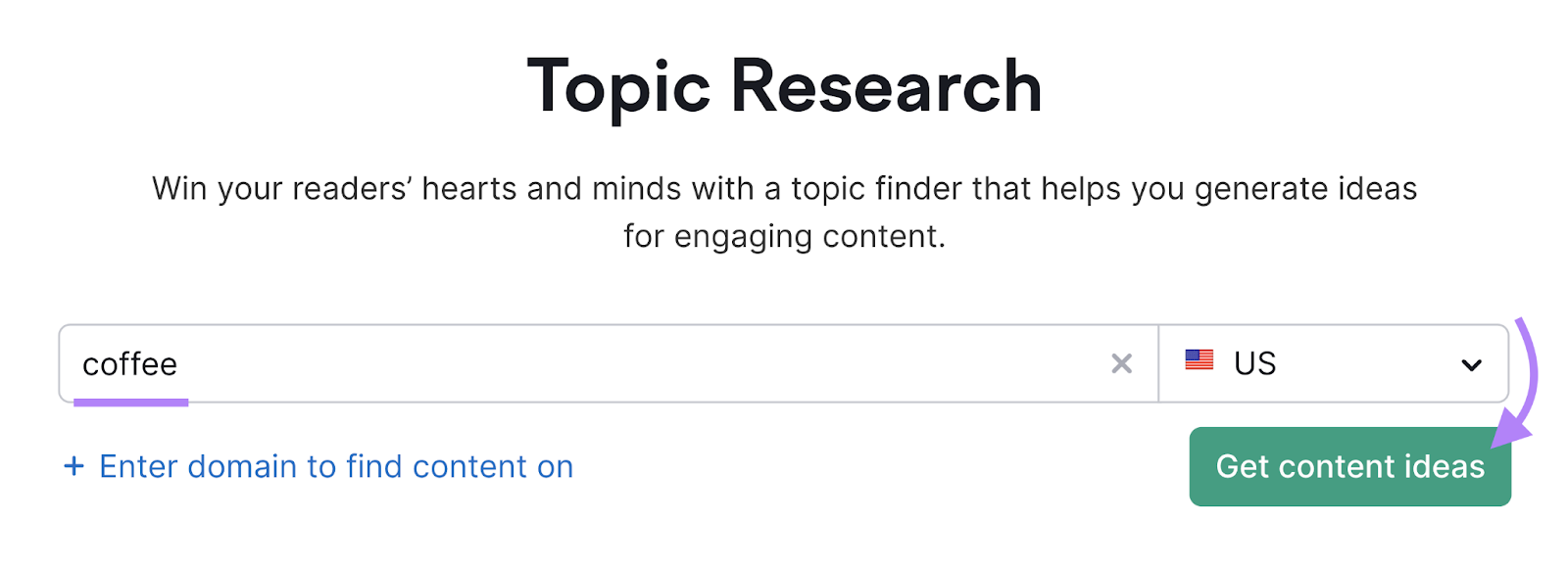
You’ll see a list of potential content ideas displayed in card-style format.
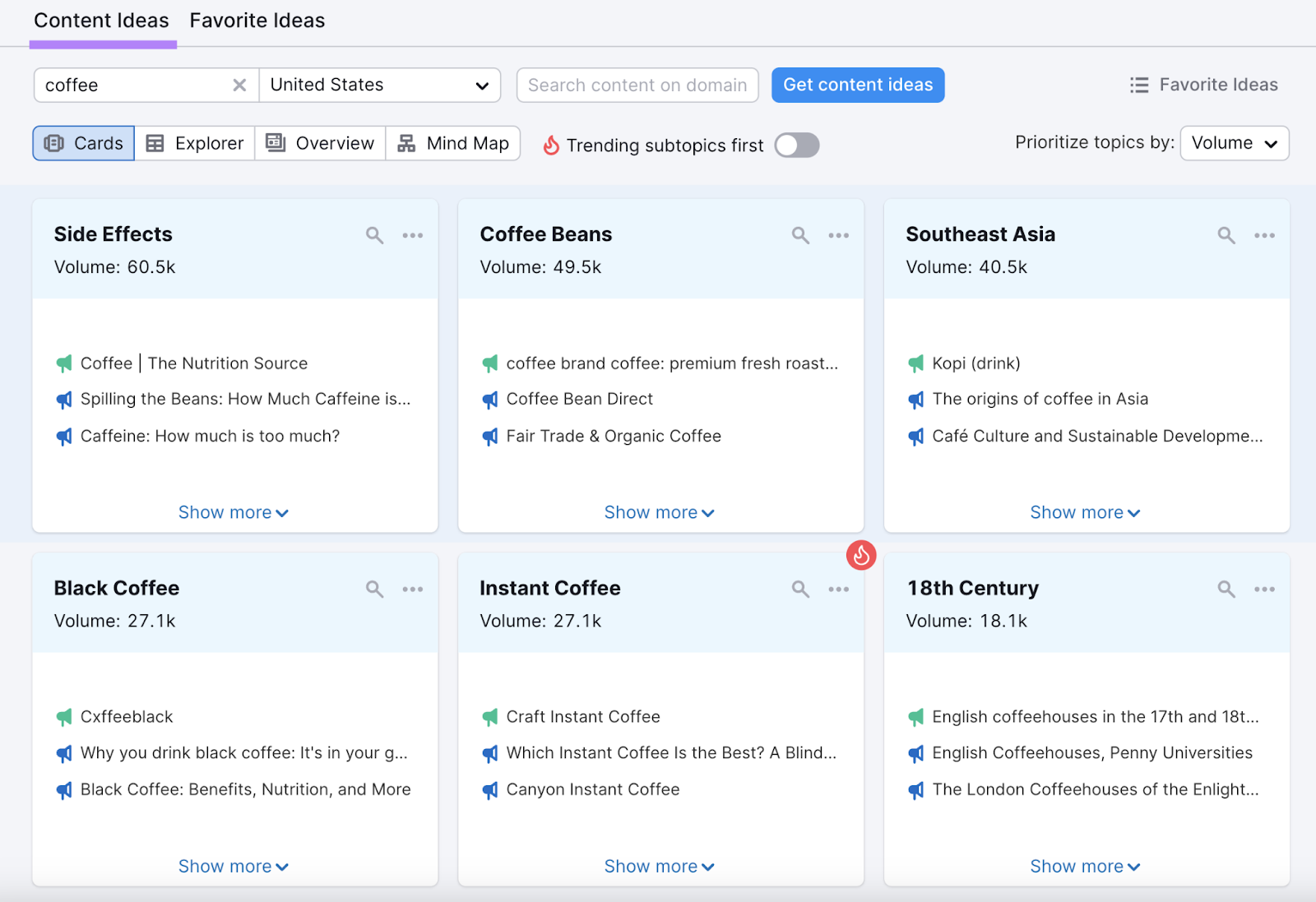
Click any card to see the top headlines from around the web, popular questions people ask Google, and related searches.
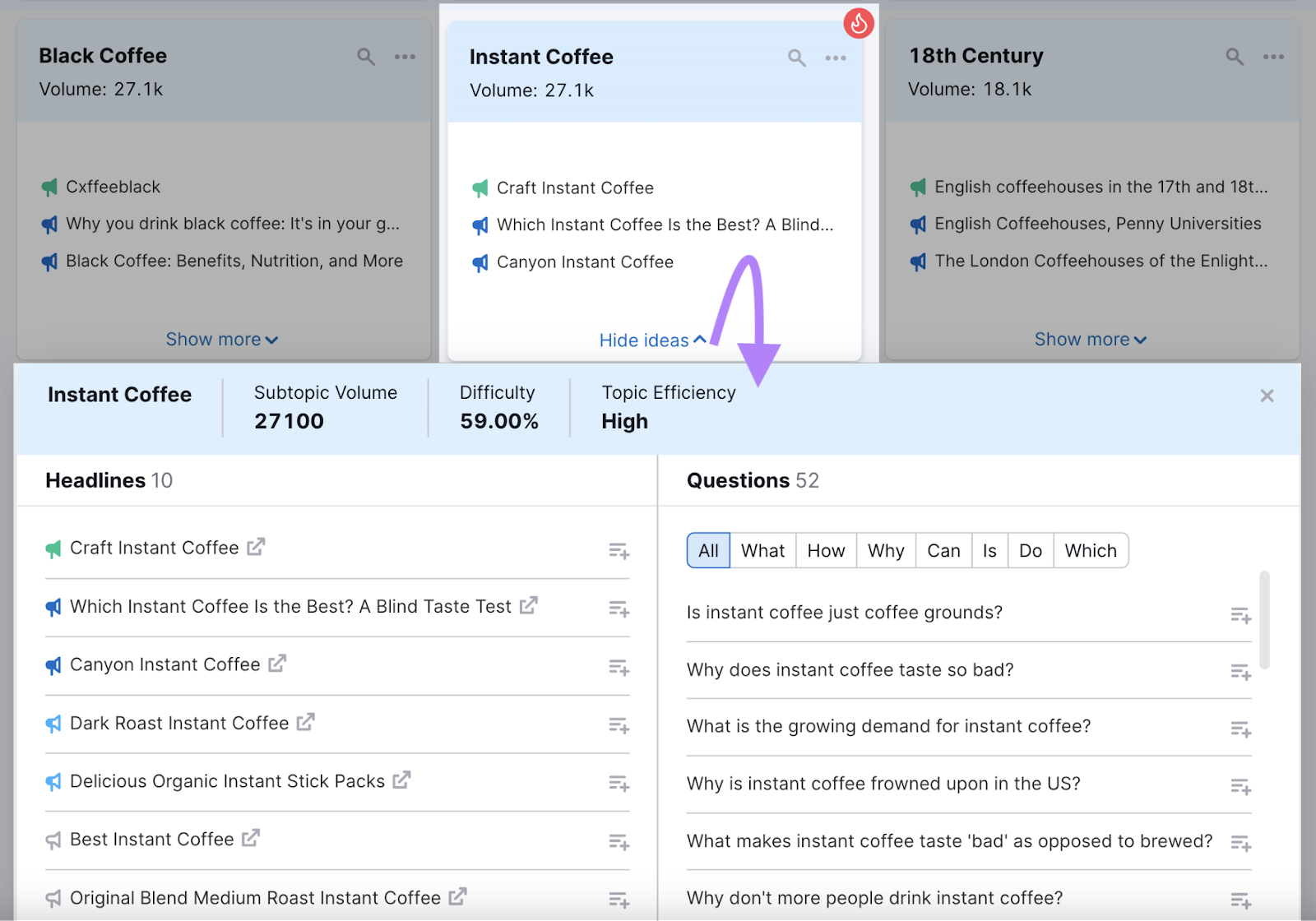
Go through the list of topics. Add the ones that look relevant as favorites by clicking the favorites icon to the right of the headline.
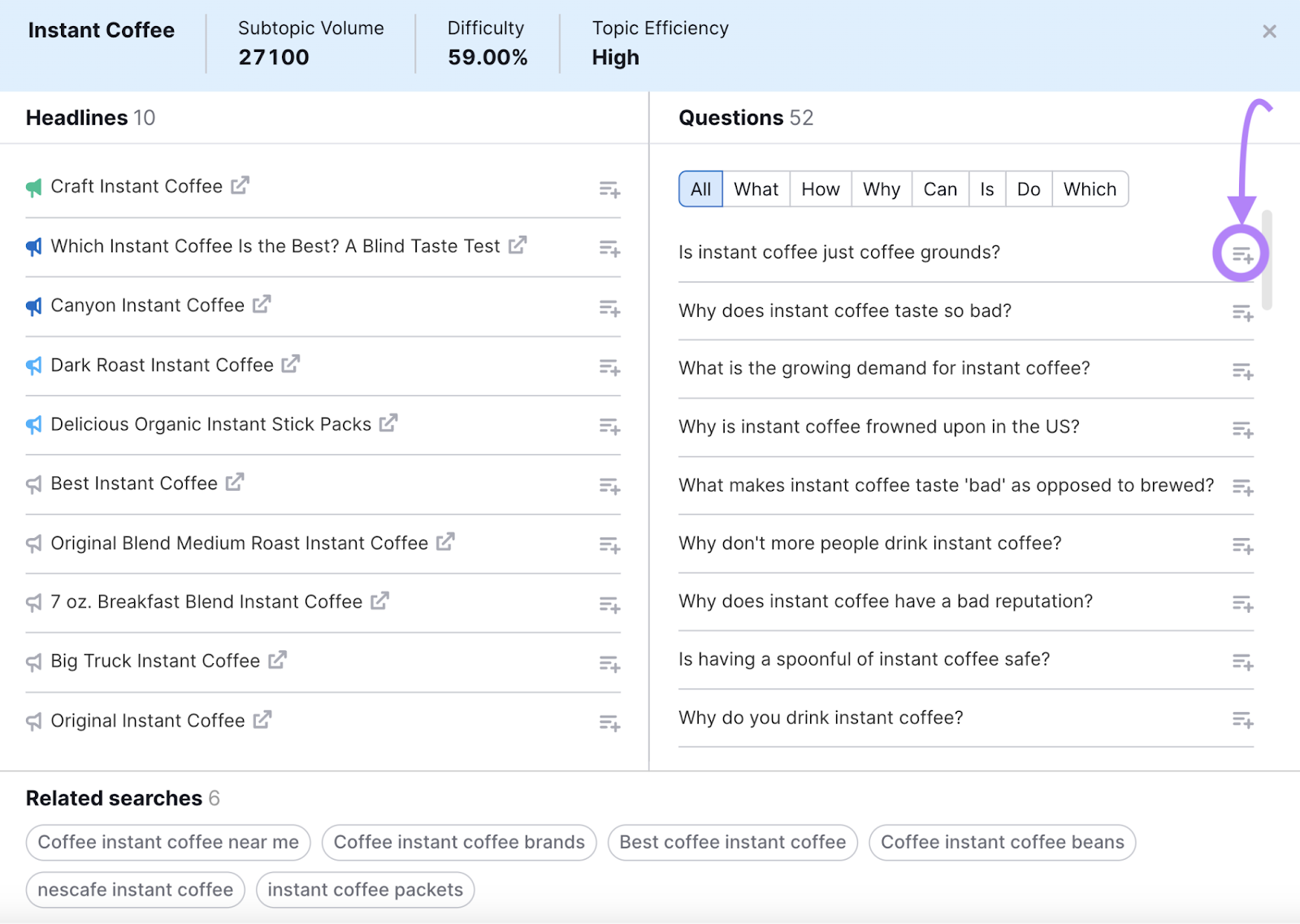
This will store all your favorite ideas under a separate tab called “Favorite Ideas.”
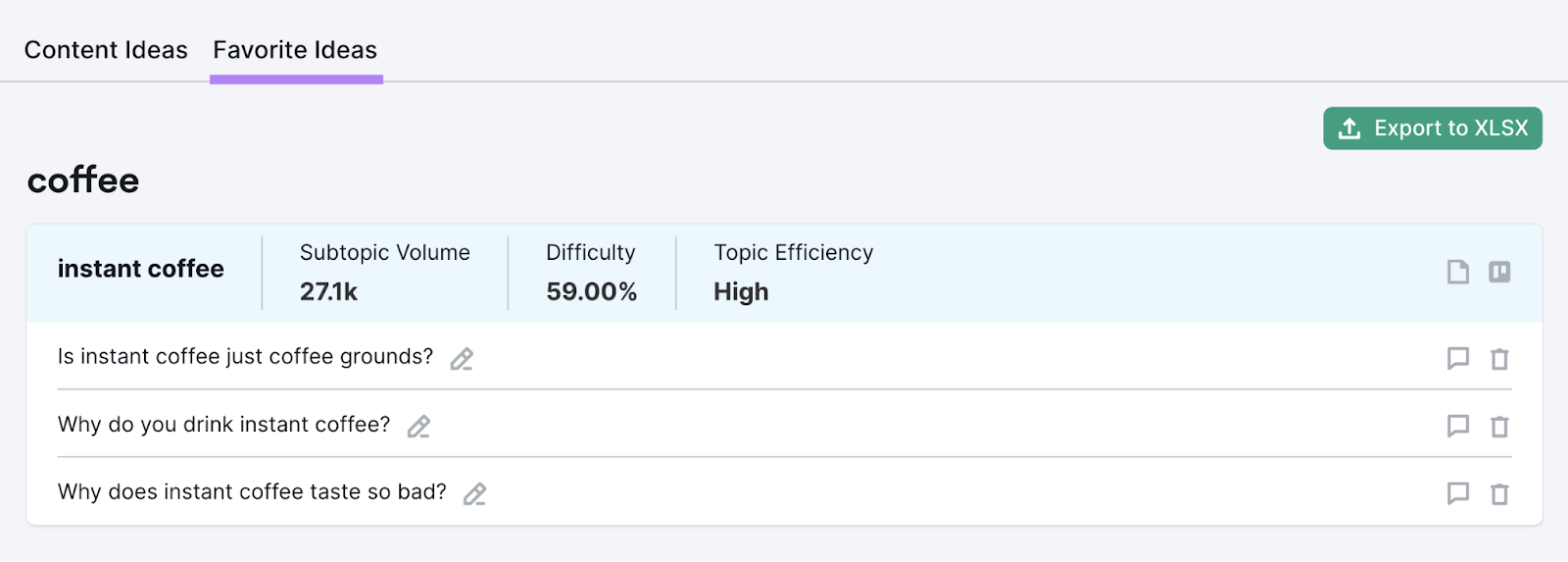
By the end, you’ll have plenty of ideas for content.
Even better:
These ideas are ones that people (aka your target audience) are looking for on Google.
2. Conduct Keyword Research
Keyword research can give you insights into your audience’s most pressing questions and interests.
Start with a broad topic or “seed” term related to your industry or business.
For instance, if you’re in sales or business technology, your seed term could be “sales CRM.” Using this term, you can uncover more specific, long-tail queries, such as “What is CRM in sales?”
This will help you curate content ideas that align with what your target audience is actively seeking and provide targeted solutions to their specific queries.
Semrush’s Keyword Magic Tool can help you find keyword suggestions in seconds.
Open the tool, enter your seed term, choose a target location, and click “Search.”

You’ll see this report:
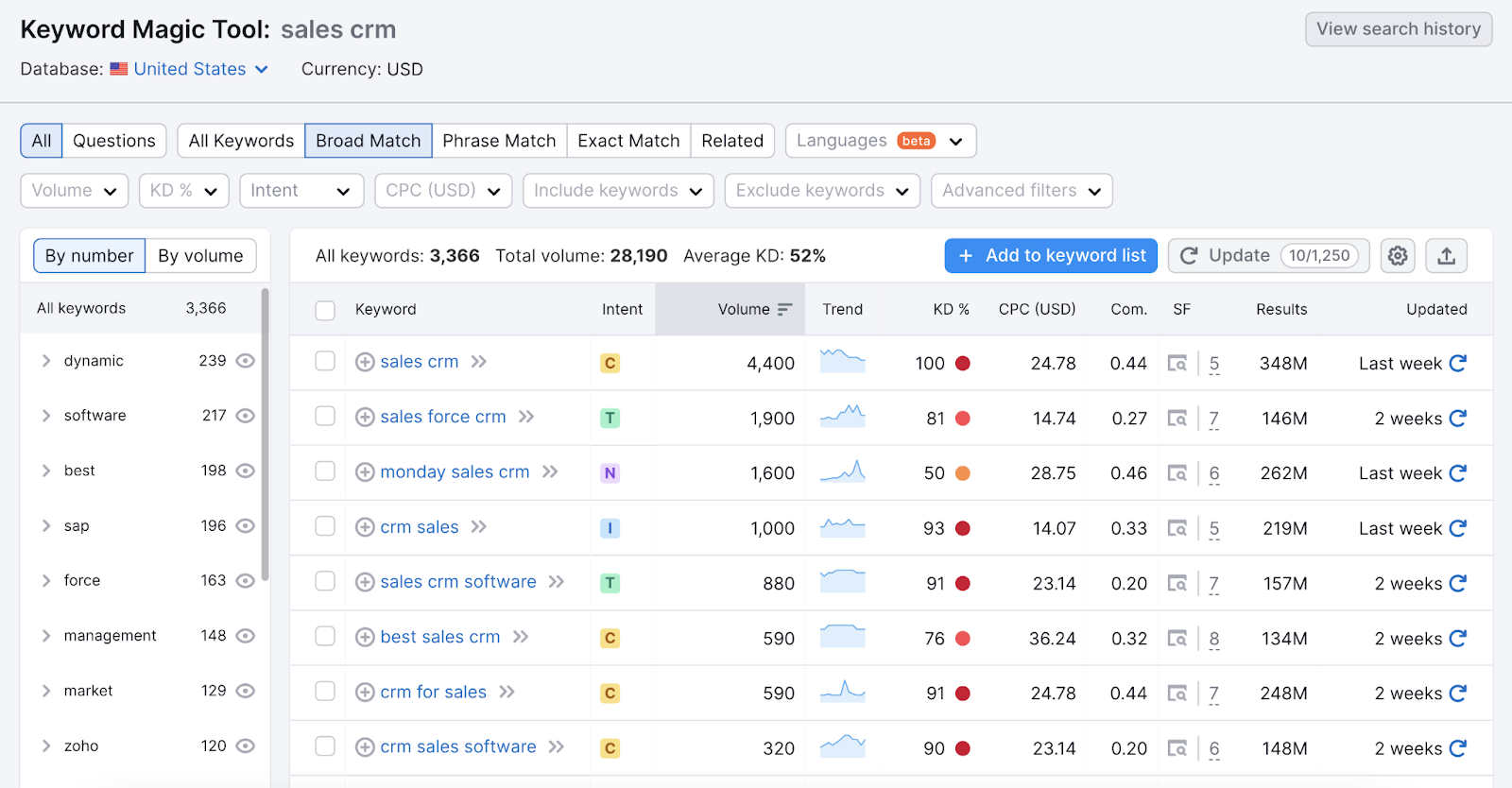
Try clicking “Exact match” from the list of filters at the top. This will give you a list of keywords closely related to your specific term.
For example, “sales CRM” will show queries exactly matching this phrase. They will help you find highly relevant content ideas.
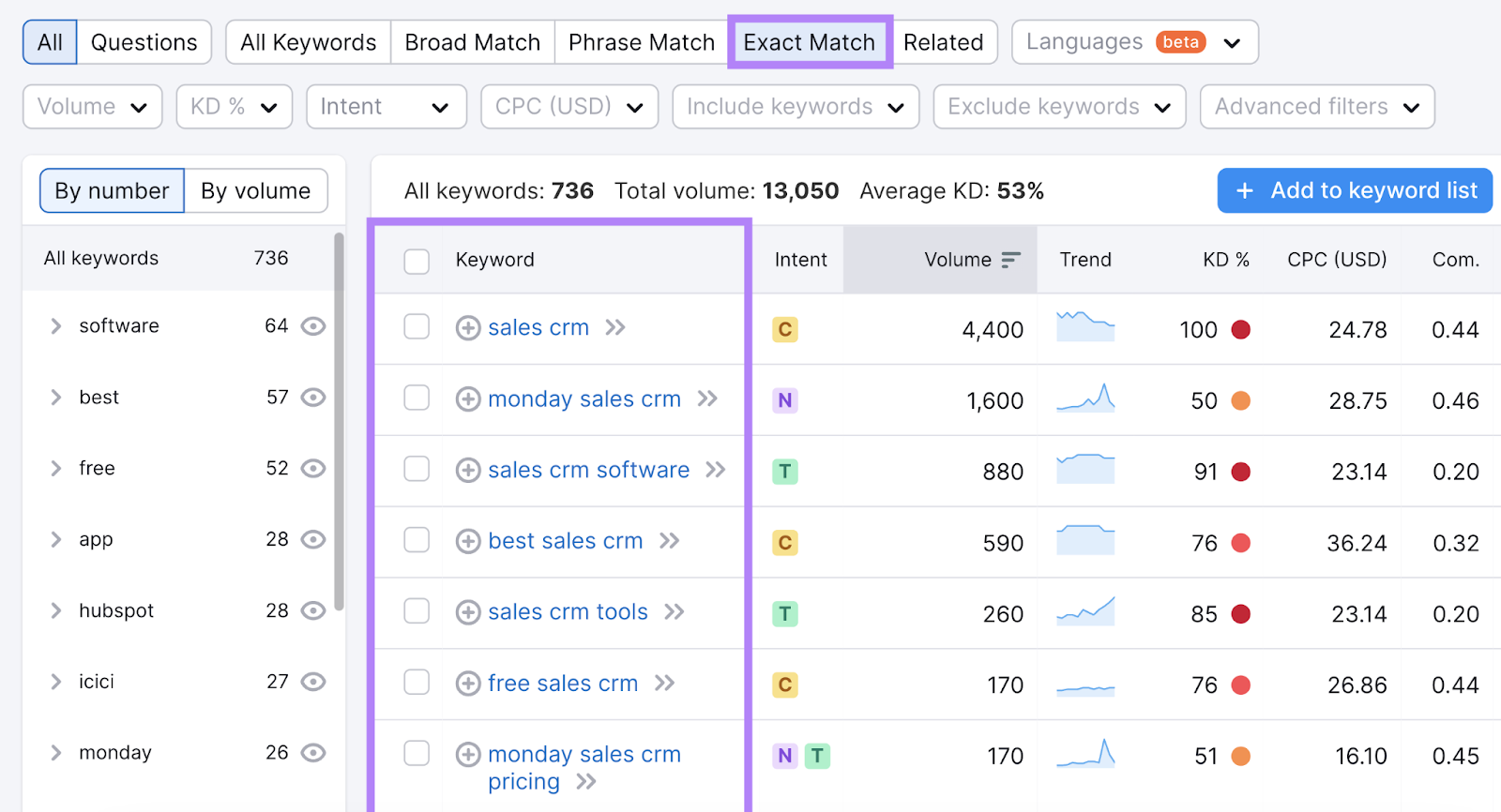
Next, click “Related.” This will give you a list of keywords similar to your seed term.
The keywords may or may not include your seed term. They will help you find broader content ideas.
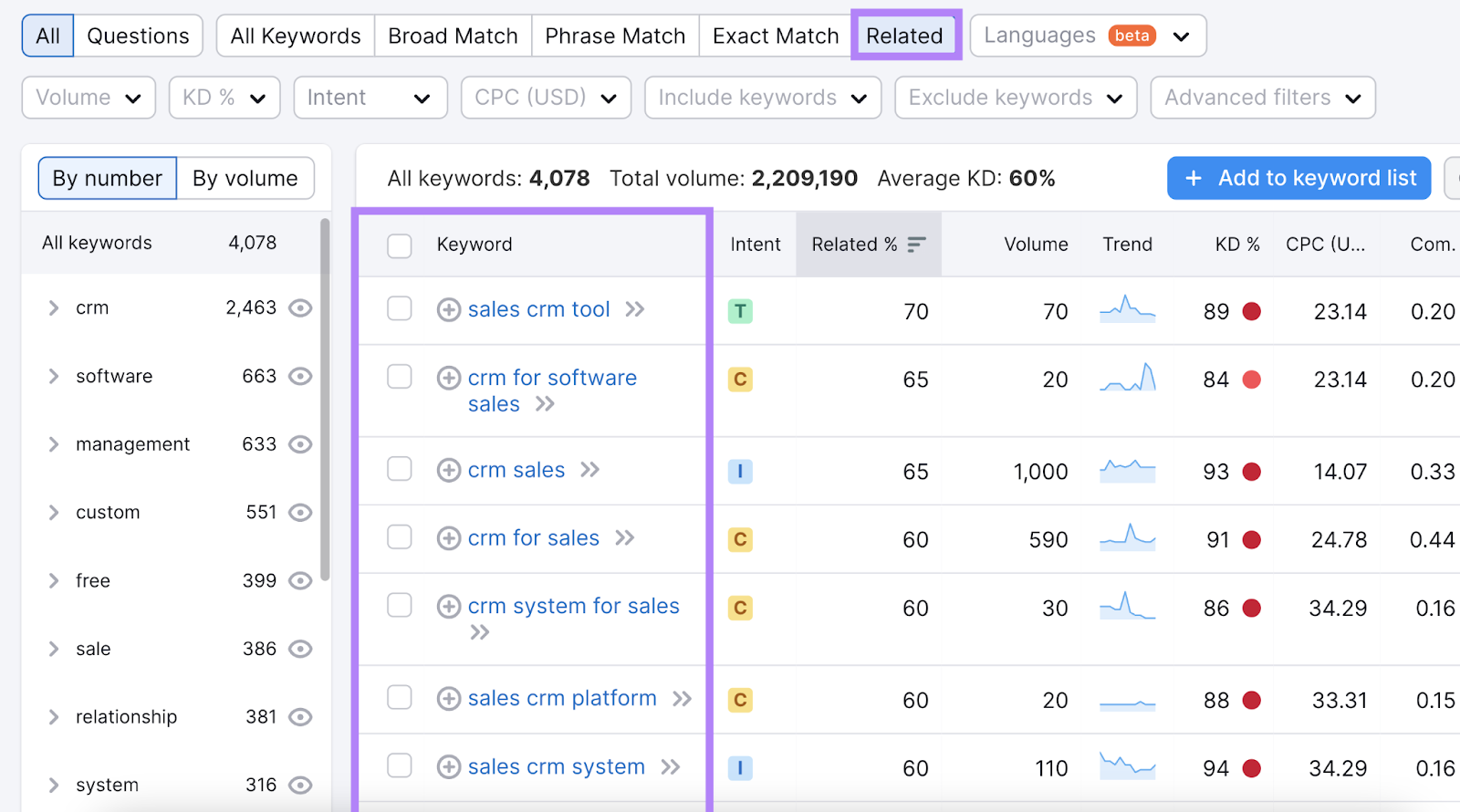
Finally, click “Questions” > “Broad match.” This will give you a list of question-based keywords that include any variation of your seed term and in any order.
Typically, this is where you’ll find a lot of content ideas.

Go through the list and select the keywords you think would be suitable for creating content.
Also, look at the “Volume” and keyword difficulty or “KD %” of the keywords you select.
- Volume: This is the estimated number of average monthly searches for a keyword over a 12-month period. Higher volume indicates more search interest.
- Keyword Difficulty (KD %): Ranging from 0 to 100, this metric shows how hard it would be to rank for a keyword. Lower KD % suggests easier ranking potential, while higher KD % indicates more competition.
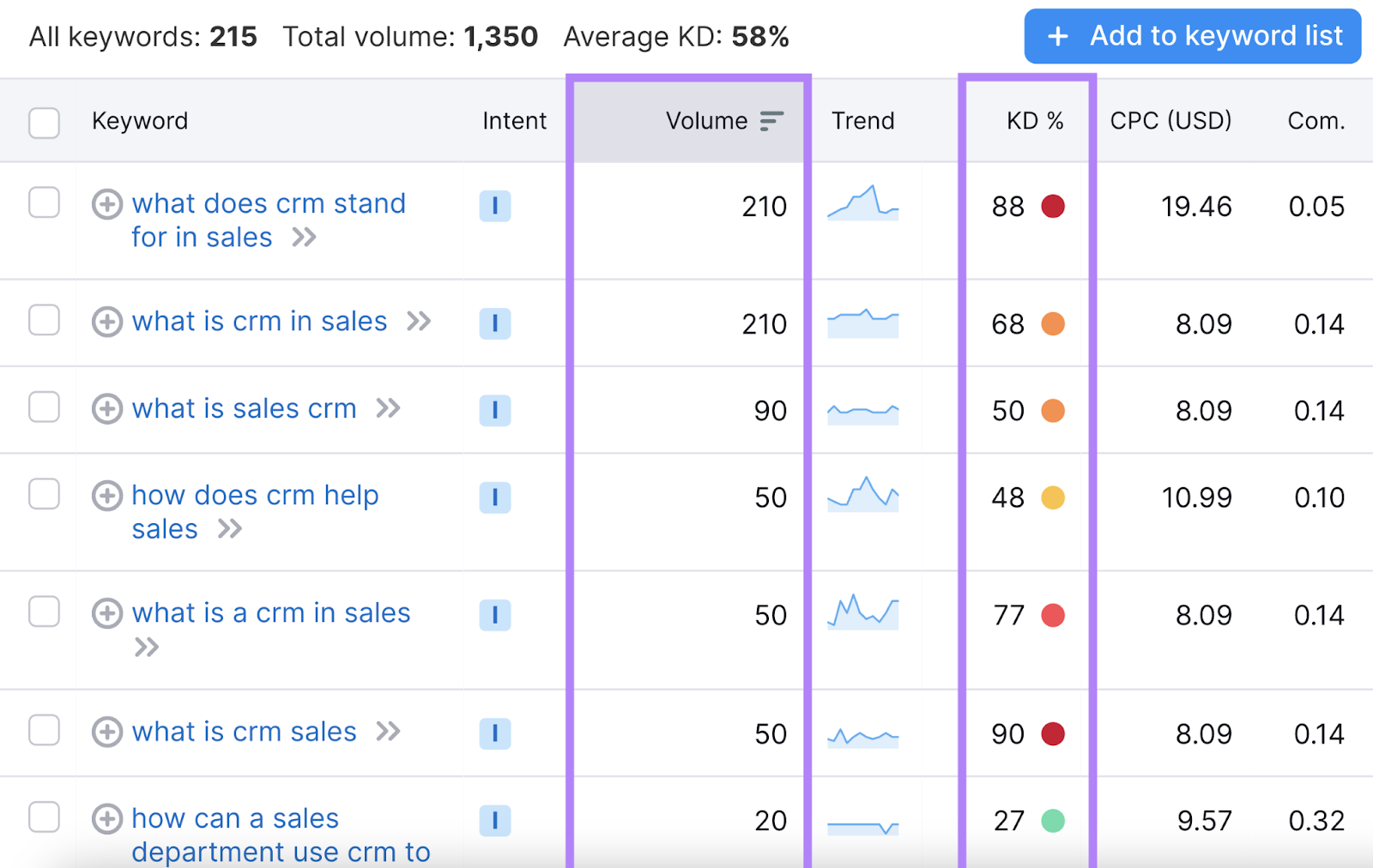
Pick relevant keywords with high search volume and low difficulty. Content built around these keywords will have more potential to rank higher faster and drive more organic traffic.
3. Look at Your Competitors’ Content Strategies
Examining your competitors’ content lets you identify gaps and opportunities in your own content plan.
Start by exploring their websites and blogs. Observe which topics they cover and the types of content they produce (such as videos, articles, and infographics).
For example, suppose a competitor’s blog series on a specific topic is driving a lot of organic traffic. In that case, it might indicate a strong interest in that topic among your shared audience.
The goal here isn’t to replicate their content but to understand what interests your target audience and how you can fill in the gaps or offer a unique perspective.
This way, you can create content that stands out—by offering your audience something different or more in-depth than your competitors.
You can find your competitors’ best-performing website content using Semrush’s Organic Research tool.
Here’s how to come up with content ideas using Organic Research:
Open the tool, enter your competitor’s domain, select the target location, and hit “Search.”
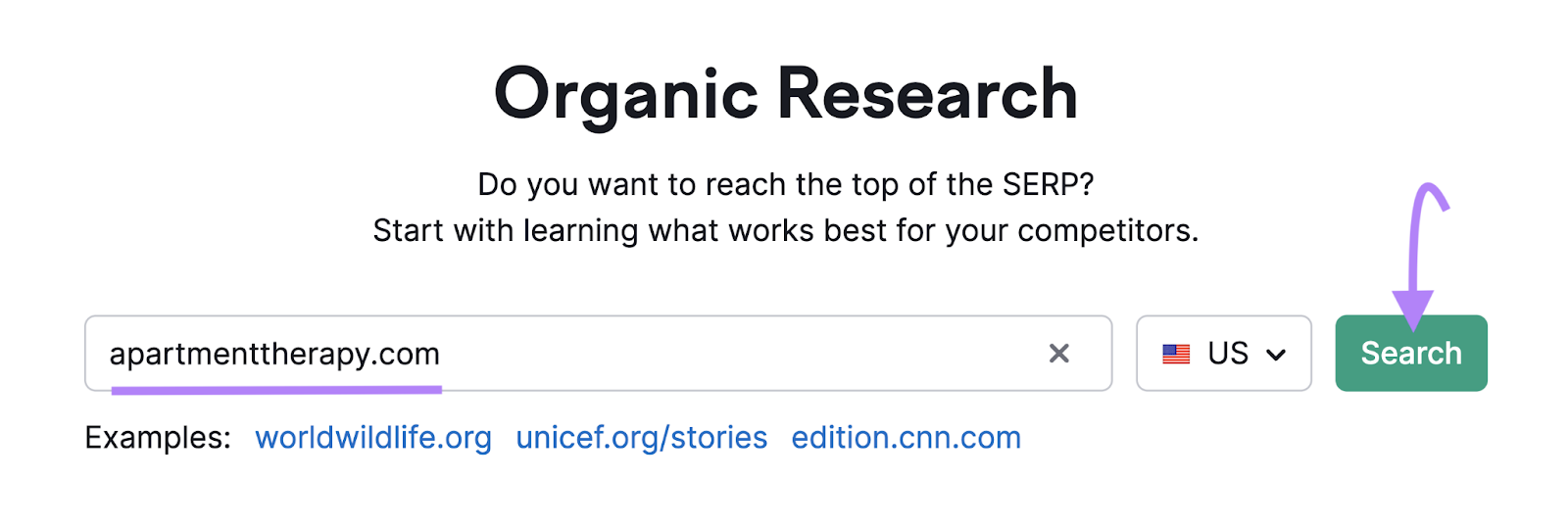
You’ll see this overview report:

Navigate to the “Pages” tab from the list of tabs at the top.

Here, you’ll find the pages on your competitor’s site, sorted by the estimated high to low organic traffic.
Look at the pages bringing the website the most traffic. What topics are they on? Can you create content on those topics?
You can even look at the keywords driving organic traffic to individual pages. Just click the number of keywords in the “Keywords” column corresponding to each URL.
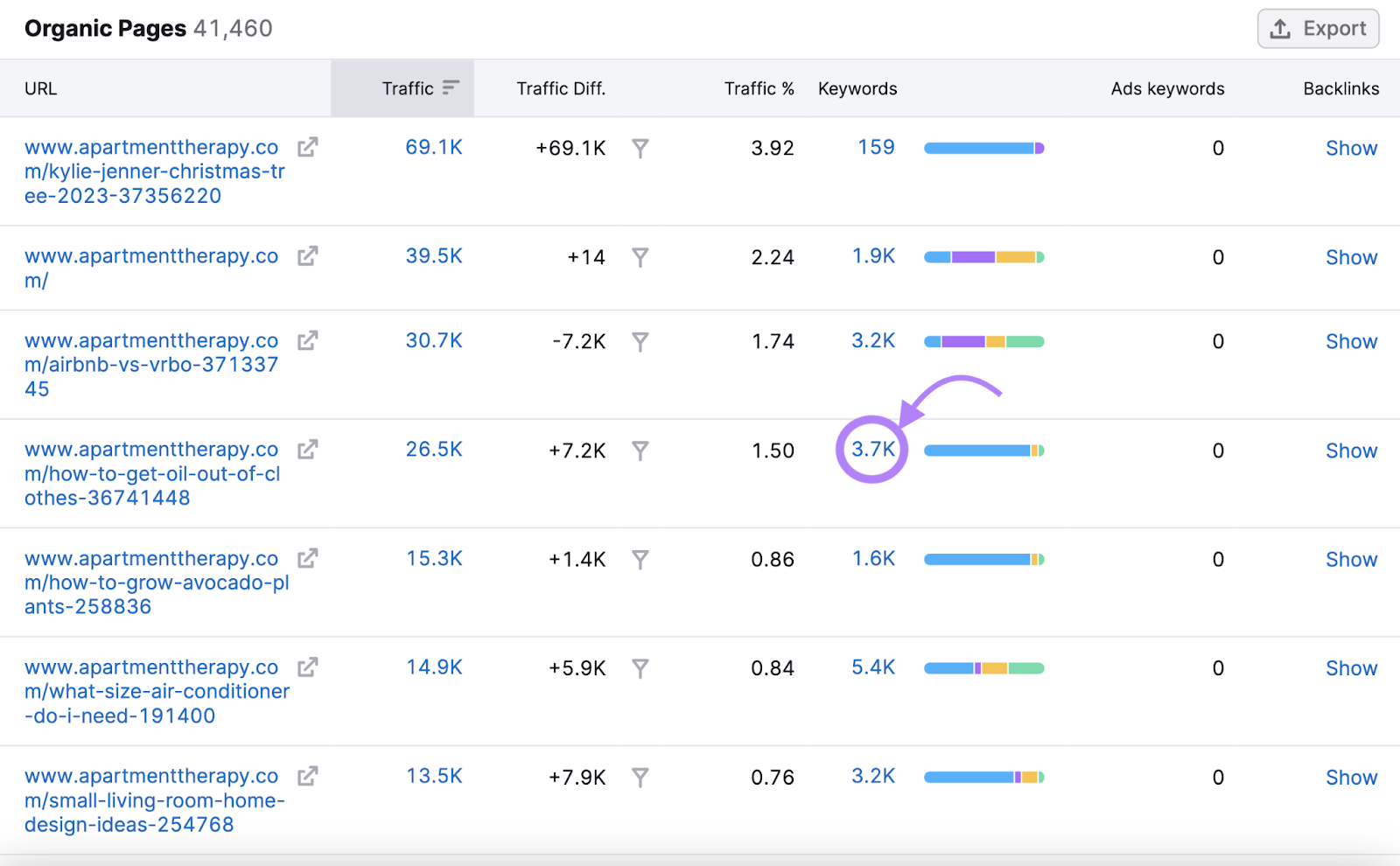
Now, you’ll see a list of keywords that specific page is ranking for and how much traffic those keywords attract.
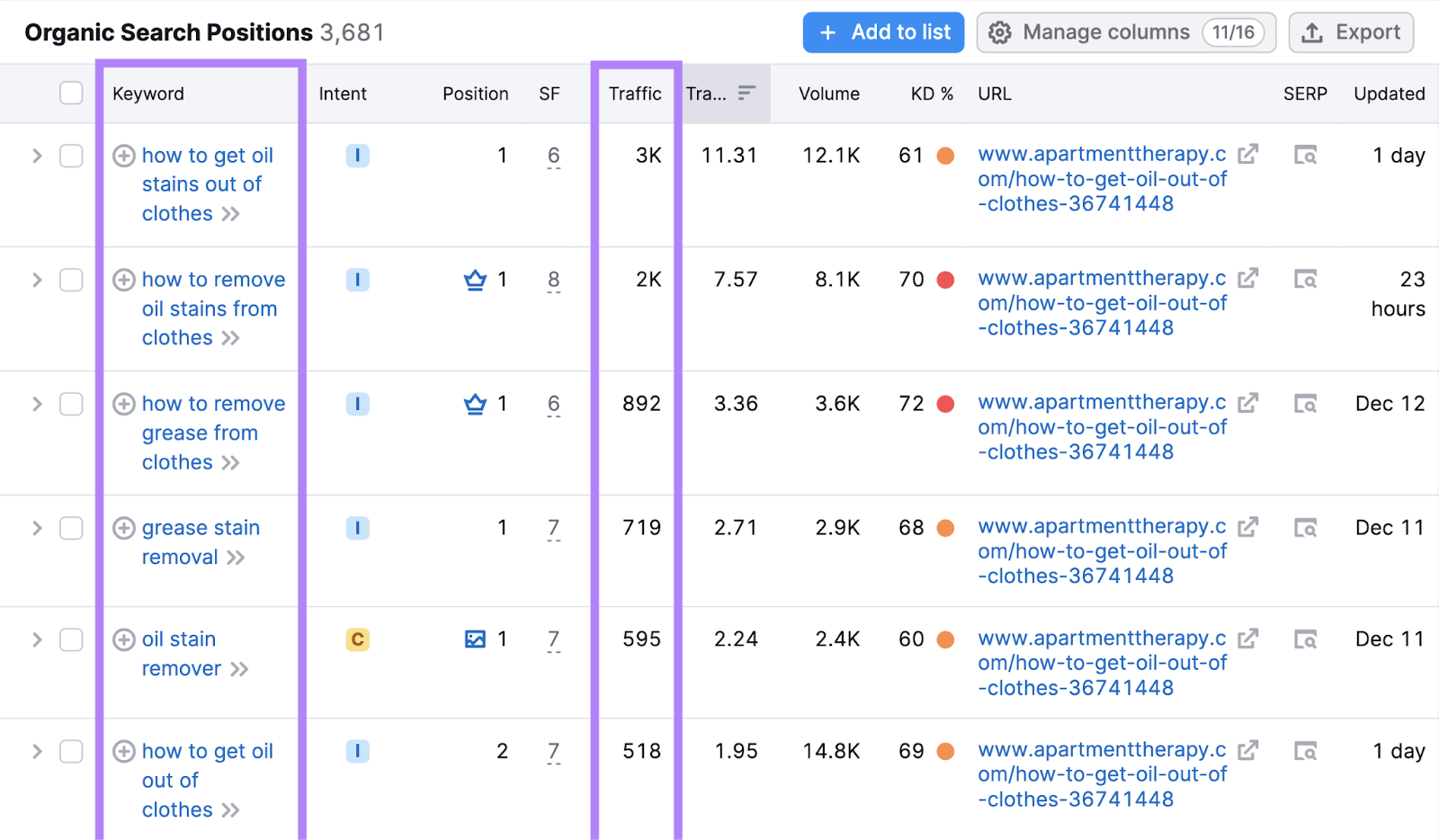
Ideally, based on this competitive analysis, you want to select topics that are:
- Working best for your competitor (in terms of driving traffic)
- Relevant to your target audience
- Optimized with keywords that are relatively easier to rank for
4. Analyze Your Most Popular Blog Posts
Review your website’s analytics to see which articles have the highest views, shares, or comments. This data is a clear indicator of the topics your readers prefer.
For instance, if a post like “5 Essential Tips for First-Time Home Buyers” is receiving significant traffic and interaction, it indicates that your audience is largely first-time buyers looking for comprehensive, easy-to-understand guidance.
Such insights can shape your content strategy to focus more on detailed guides, step-by-step processes, and perhaps even personal stories of first-time homebuying experiences.
So, creating more posts around home buying and residential property investment tips can be a strategic move to keep your audience engaged and coming back for more.
You can find top pages on your site using Google Analytics.
Go to your Google Analytics account, click “Reports” > “Engagement” > “Pages and screens.”
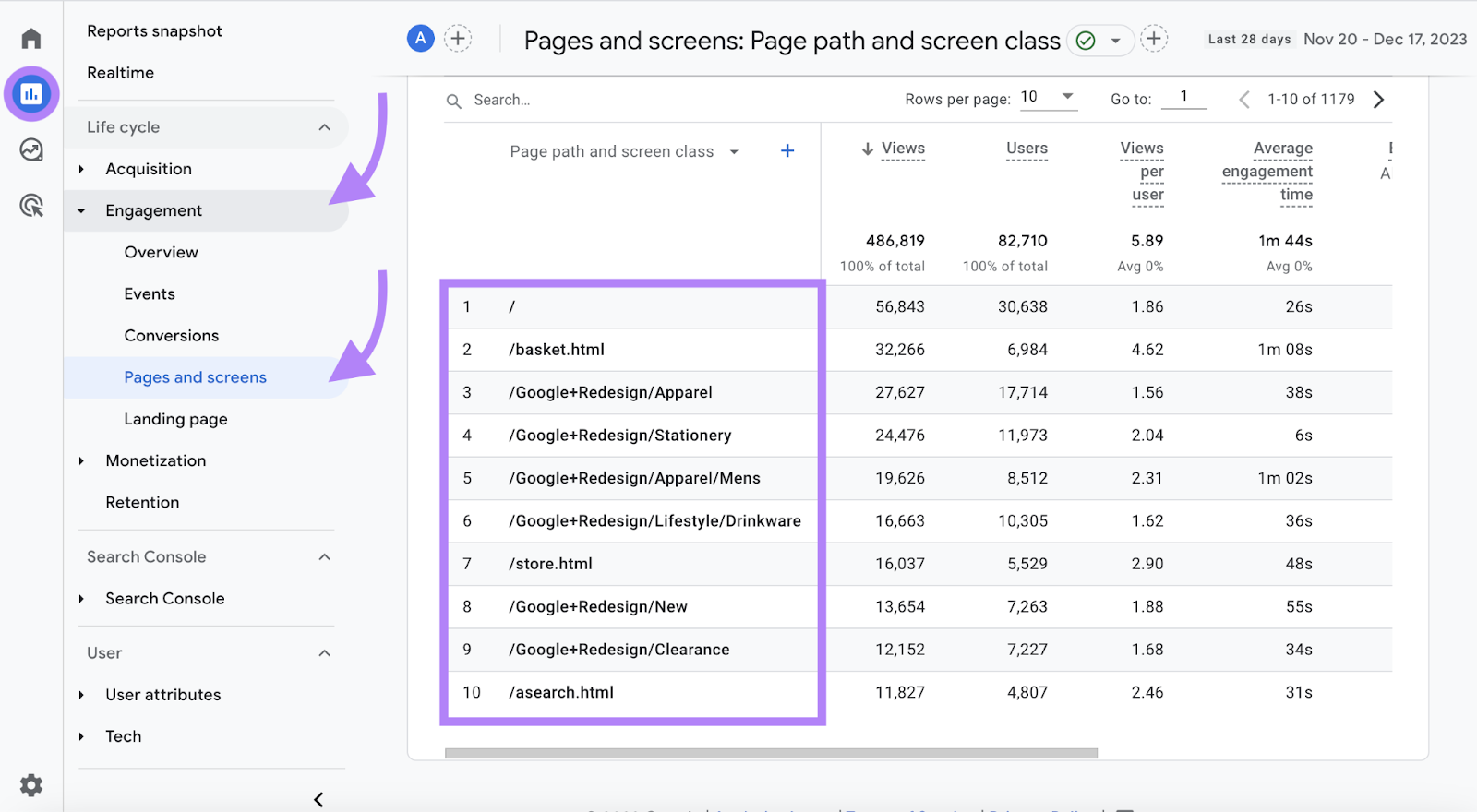
You can keep your content strategy aligned with your audience’s evolving interests and needs by regularly reviewing Google Analytics data.
5. Try ChatGPT
You can use ChatGPT to brainstorm fresh content ideas. The AI tool can generate topics, headlines, and rough outlines for your articles.
Start by giving it a prompt related to your field.
For example, if you’re in the travel industry, you might ask:
“I want to write an article about solo traveling with the goal of getting hotel bookings through my affiliate links. Can you give me 10 content ideas for articles that will achieve those goals?”
ChatGPT will generate a range of ideas based on your prompt.
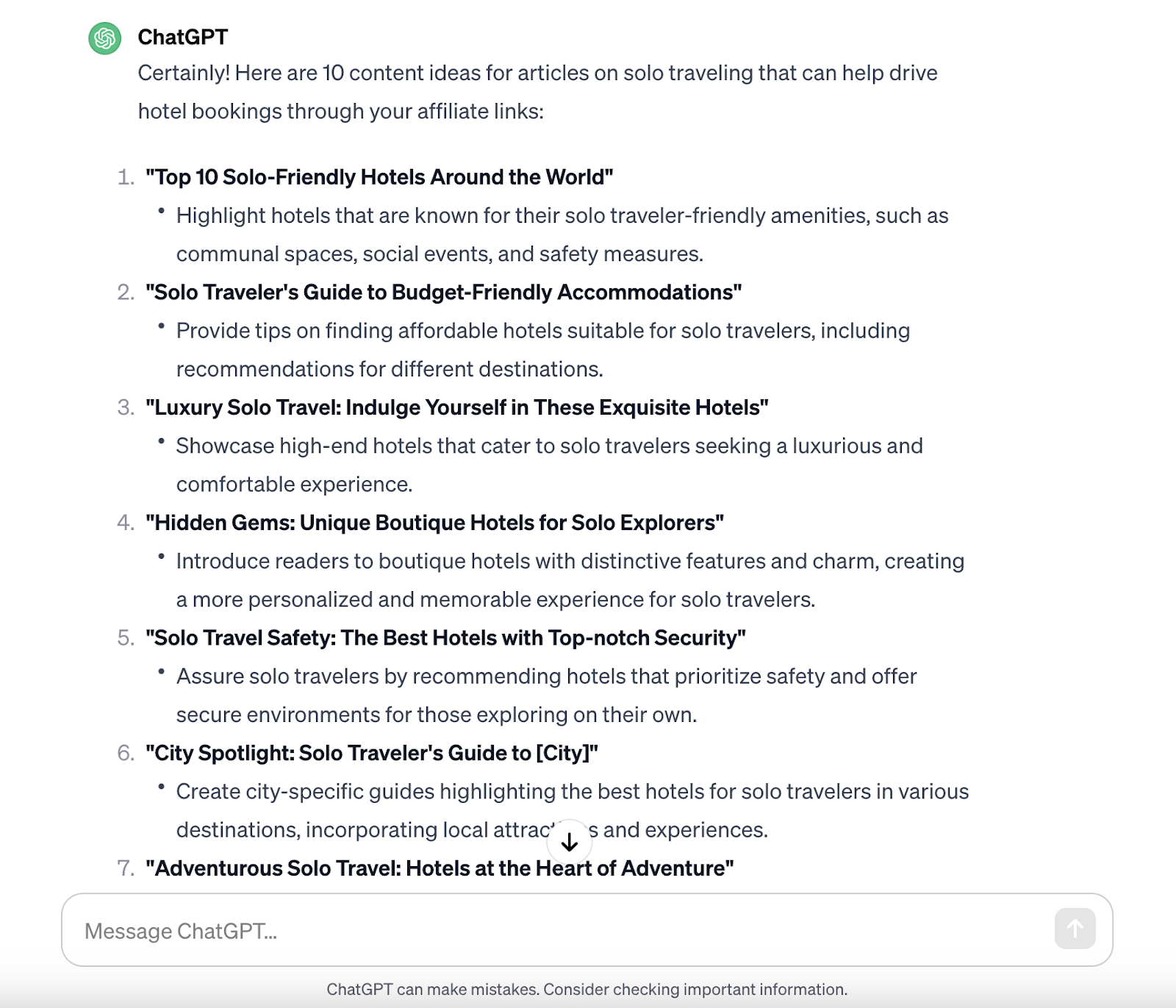
You can refine these suggestions, combine them, or use them as a starting point for more detailed research.
ChatGPT is particularly useful when you’re looking for fresh angles on familiar topics.
Keep in mind: The more specific your prompt, the more tailored the responses will be.
Further reading: 195 ChatGPT Prompts (& How to Write Your Own)
6. Use ContentShake AI
ContentShake AI is a comprehensive writing tool that assists in the entire content creation process. It doesn’t just give you ideas; it even composes unique content for you in seconds.
The tool uses AI and machine learning to give you tailored topics.
You can generate content ideas with ContentShake AI by entering a seed keyword related to your business, product, or industry.
You’ll also see suggestions for related tags. Once you choose the desired tags, click “Start writing.”
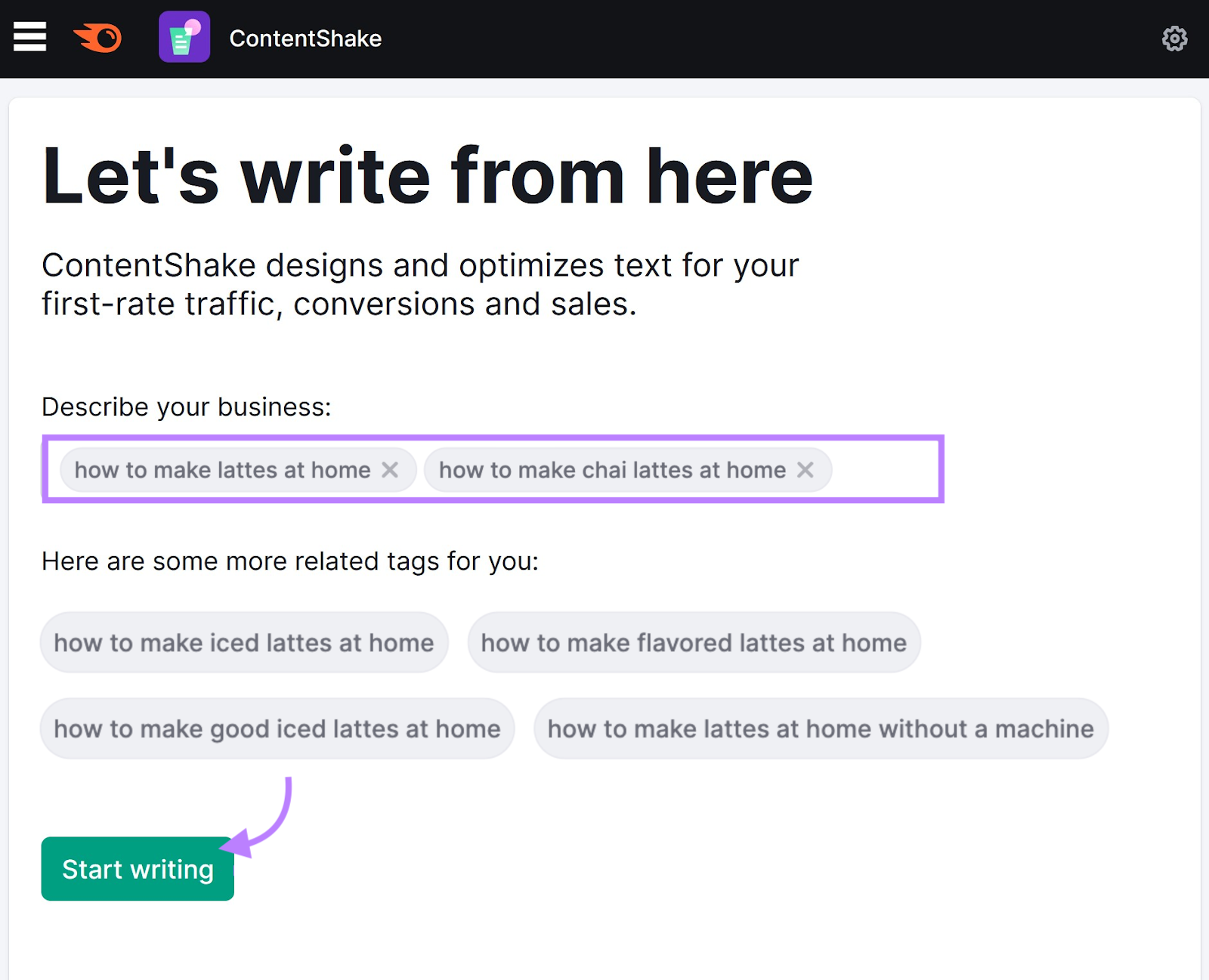
The tool generates a list of potential article ideas.
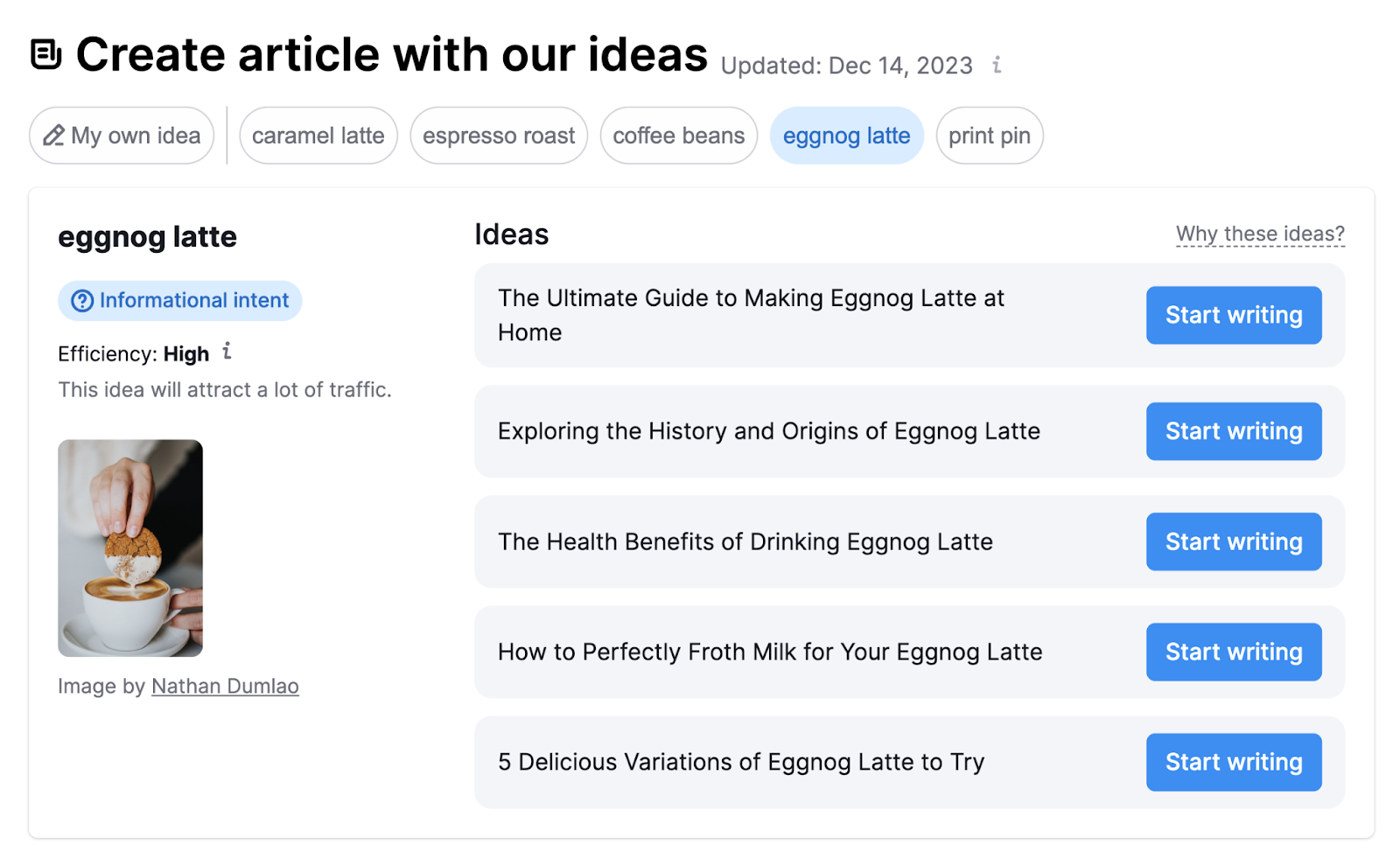
It categorizes the ideas by search intent, which is the underlying purpose or goal of a user’s search query.
There are four broad types of search intent:
- Navigational: The user aims to find a specific website or page, like “Facebook login”
- Informational: The user seeks information or answers to questions, such as “How to tie a tie”
- Commercial: The user looks for information before making a purchase decision, like “best smartphones 2024”
- Transactional: The user intends to complete a specific action or purchase, such as “buy iPhone 12 online”
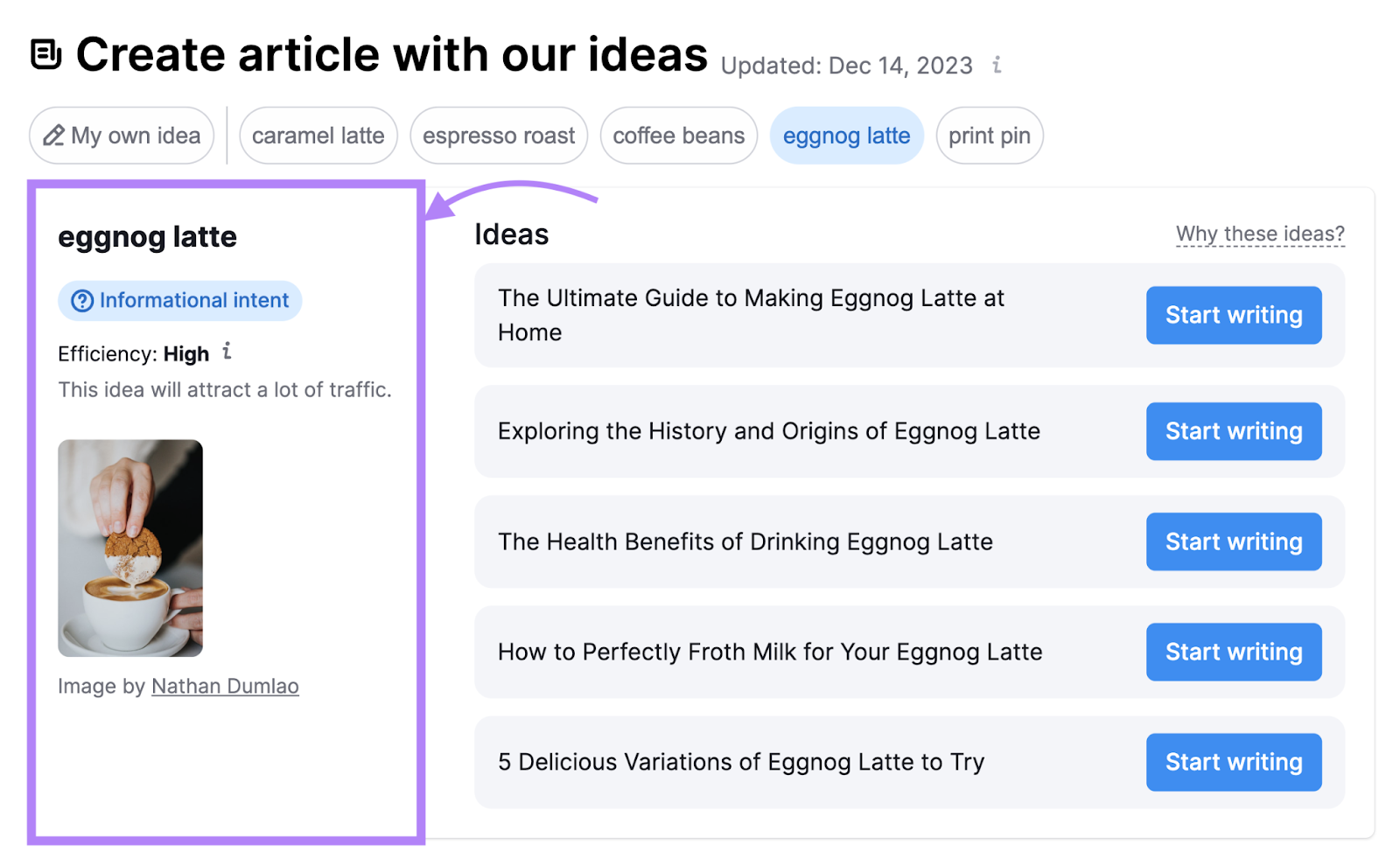
Review the ideas and click the one you’re interested in creating content for.
Next, click “Start writing.” ContentShake AI will generate the first draft of your article.

You’ll find several data points and recommendations. Like what keywords you can add to the text to optimize it better or what sentences can be reworked for better readability.
You can improve your first draft by editing and optimizing it.
Once the content is finalized, you can even publish the article directly to your WordPress blog.
7. Join Social Media Conversations
Social media conversations within your industry or niche are a goldmine of content generation ideas.
Why?
Because they help you understand your audience’s interests and preferences. And based on that, you can develop interesting content ideas.
For instance, if you’re in finance, join Facebook groups dedicated to money-saving.

Or follow hashtags like #FinanceTips on Instagram.
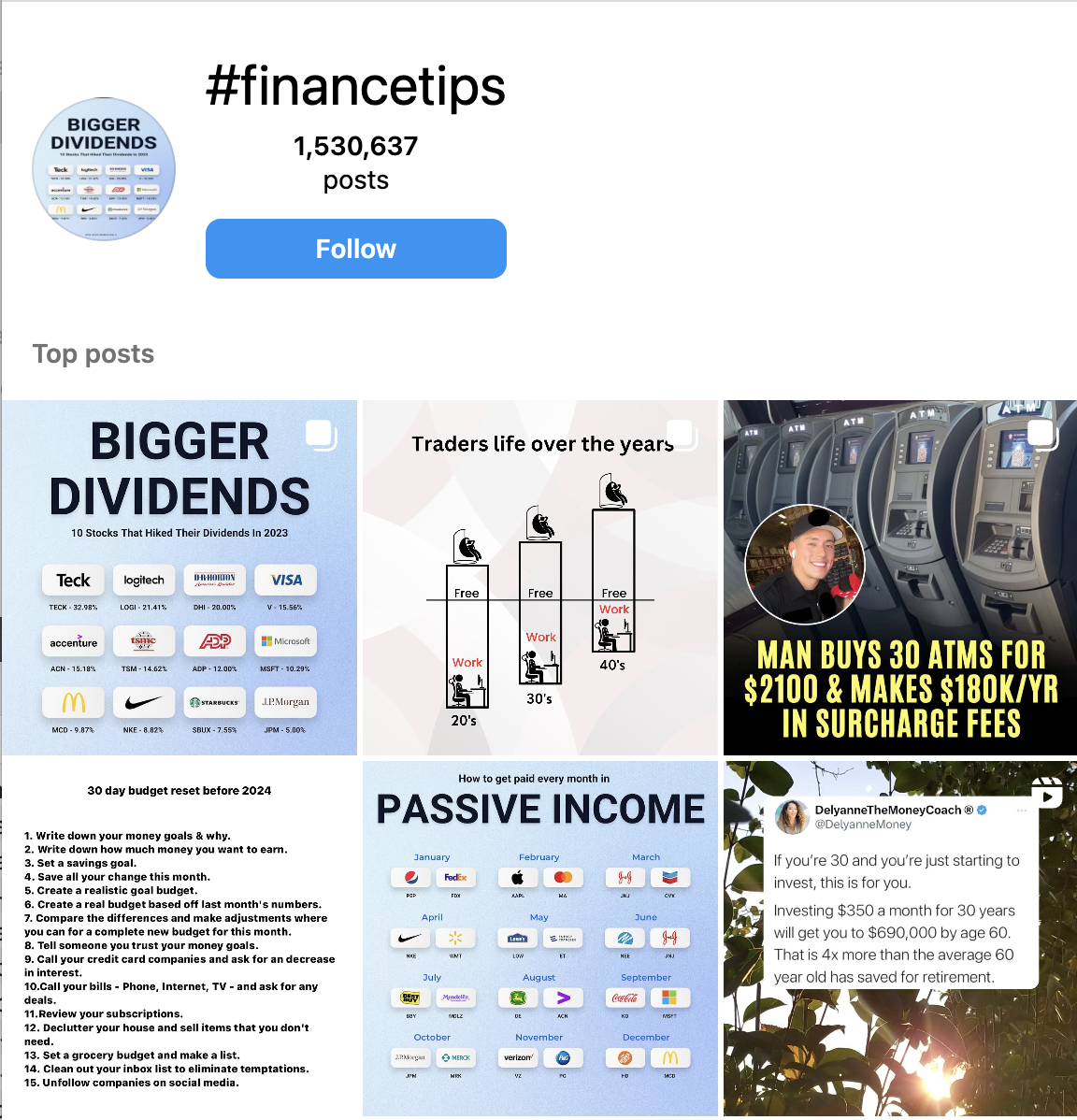
When observing these platforms, you might find that discussions about “budget-friendly investment strategies” are gaining traction, with increased questions and engagement on such posts.
This isn’t just casual conversation; it reflects a keen interest among your audience in this area right now.
You can leverage this information by creating content that directly addresses these interests.
For example, based on the active discussions, you could write a blog post titled “5 Budget-Friendly Investment Strategies for 2024” or produce a series of Instagram posts offering quick tips on the subject.
This ensures your content resonates strongly with your audience’s current concerns and interests.
8. Talk to Industry Thought Leaders
Engaging with industry thought leaders can be a rich source of content ideas on emerging topics.
These interactions provide firsthand expert knowledge and add credibility and depth to your content.
You can use these insights to create detailed articles, reports, Q&A sessions, or expert roundup posts, offering diverse perspectives from the forefront of your industry.
For example, Semrush recently published a detailed social media trends report for 2024. It features several of the industry’s leading names who gave their opinions and insights.
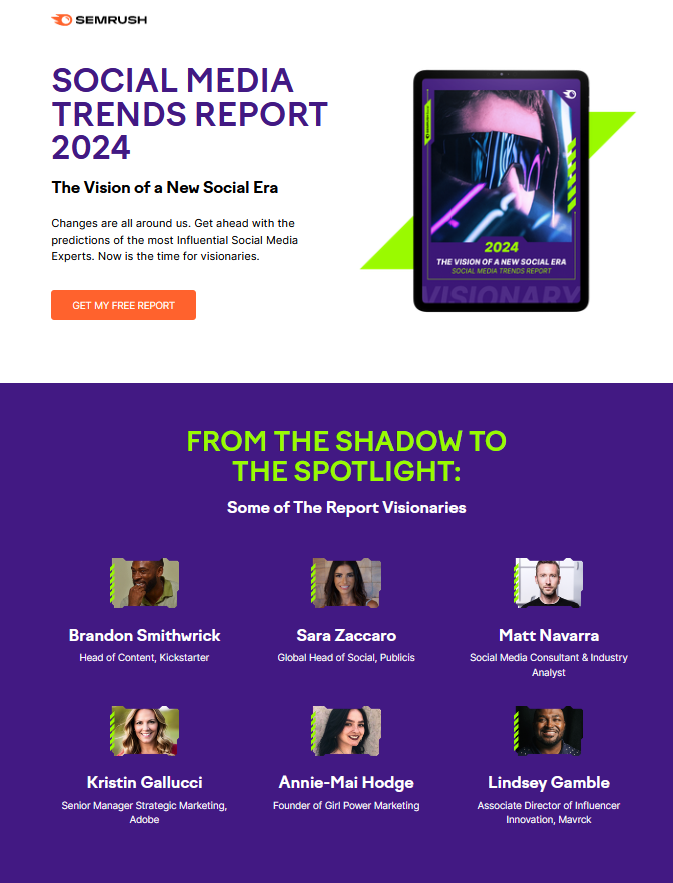
To reach out to experts for interviews, consider using professional networks like LinkedIn, attending industry conferences where thought leaders speak, or participating in online webinars and forums related to your field.
These platforms offer opportunities to connect with experts whom you can then request interviews with or invite to share their insights.
This way, you not only curate valuable content for your audience but also build your network within the industry.
9. Read Key Opinion Leaders’ Interviews
Analyzing interviews of key opinion leaders (KOLs) in your industry can reveal insightful content ideas.
You can find these interviews in industry magazines, podcasts, or YouTube channels.
Pay attention to the topics they discuss, the predictions they make, and the advice they give.
For instance, here’s a takeaway from an interview with OpenAI CEO Sam Altman:

If you’re in a tech-related niche, you can create many pieces of content based on this interview.
For instance, you could write a prediction-based article like “How AI Will Impact Employment in the Next 5 Years,” providing an in-depth look at future trends.
Alternatively, a listicle such as “10 Ways AI is Transforming the Hiring Process” can offer readers a concise overview of the changes to expect in the coming years.
Following KOLs helps you stay on top of industry trends and provides your audience with cutting-edge information.
10. Explore Google Search Suggestions
Google Search suggestions (also called autocomplete) are a quick way to identify what people are searching for in real-time.
When you start typing a topic into Google’s search bar, it automatically suggests related search terms based on popular queries. You can use these suggestions to find highly targeted content ideas.
For example, typing “healthy eating” might bring up suggestions like “healthy eating plate” or “healthy eating for kids.”

This gives you a direct look at what people are currently interested in—allowing you to create content that is both relevant and likely to perform well in search results.
From the example of “healthy eating for kids,” you could create a variety of engaging content.
Consider a video series showing how to make fun, colorful, and healthy food plates that appeal to children. Or, compile a listicle of quick, nutritious recipes ideal for kids’ meals.
You can further explore these topics using tools like Google Trends to gauge their popularity over time.
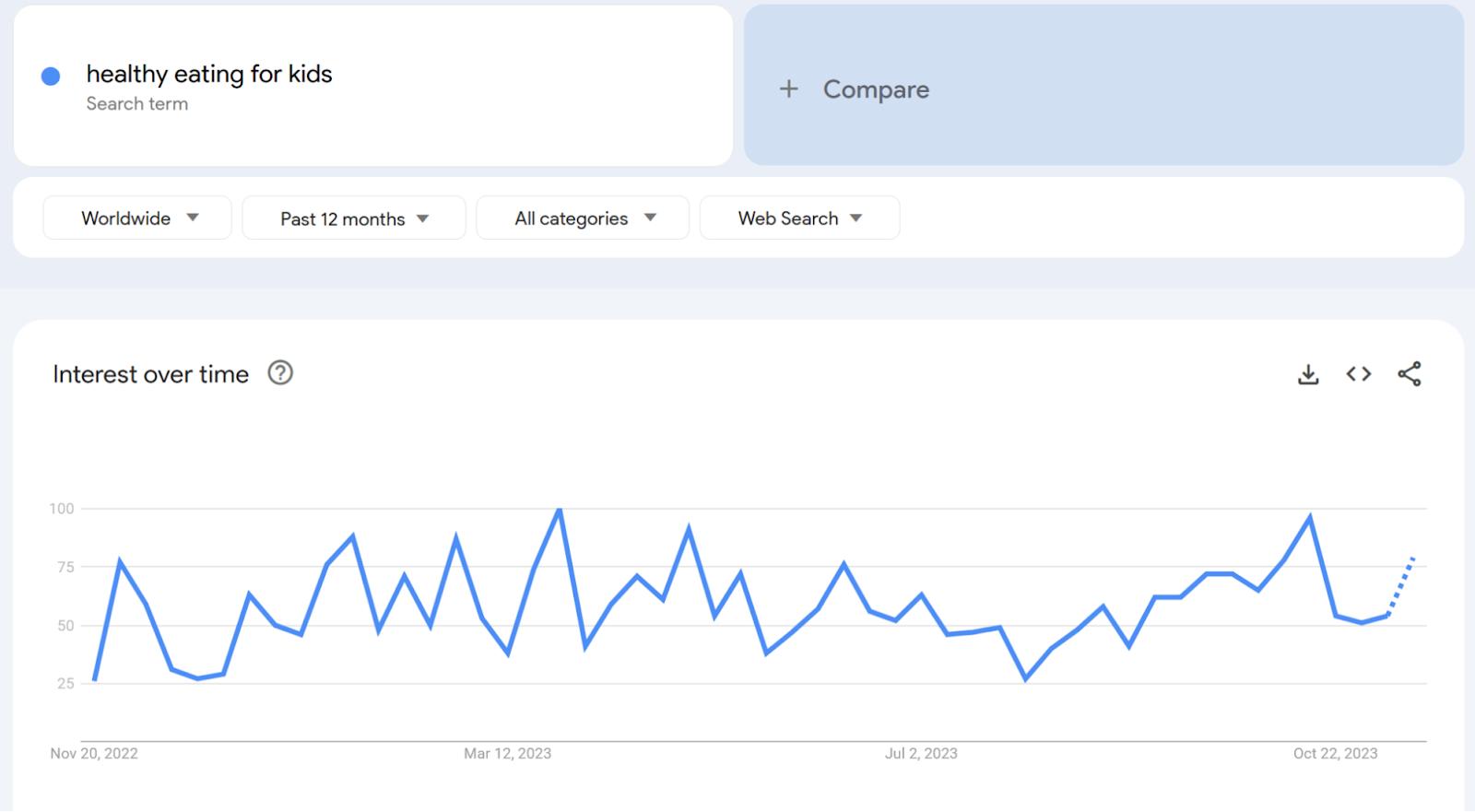
11. Learn from Google Search Console Data
Google Search Console (GSC) gives a clear picture of what draws visitors to your site. It shows the queries people use to find your site and how it appears in search results.
You can identify topics already resonating with your audience by analyzing this data.
For instance, if you find that a lot of traffic comes from searches related to “beginner yoga poses,” it may be a sign to create more content around yoga for beginners.
This could include a detailed article on “Yoga Poses for Stress Relief” with instructional photos and a “10-Minute Yoga Routines for Beginners” video for social media.

This targeted approach ensures your content is relevant and meets your audience’s needs and interests.
12. Share Your Personal Experiences
Your personal experiences can be a powerful source of content.
Sharing your journey, challenges, and successes makes your content relatable and can resonate with your audience.
For example, if you run a small business, dive into the practicalities of its day-to-day operations. This could include insights into effective team management, the process of product development, or the strategies you’ve implemented for customer retention.
Sharing these operational details provides a glimpse into the realities of managing a business and offers valuable lessons drawn from your own experiences.
Here’s Joel Gascoigne, CEO and co-founder of Buffer, sharing his behind-the-scene thoughts on the company’s blog:

The personal touch differentiates your content from others and establishes a stronger connection with your readers.
It can inspire, educate, and encourage engagement. Making your website or social channels a source of genuine insights and stories.
13. Subscribe to Industry Newsletters
Subscribing to industry newsletters is a smart way to stay informed and get inspired. These newsletters often cover your field’s latest trends, breakthroughs, and updates.
Regularly reading them lets you stay ahead of the curve and find new angles for your content.
For instance, if you’re in the digital marketing field, subscribing to newsletters like Marketing Brew can provide you with a steady stream of current topics, such as the latest viral ads or social media trends.
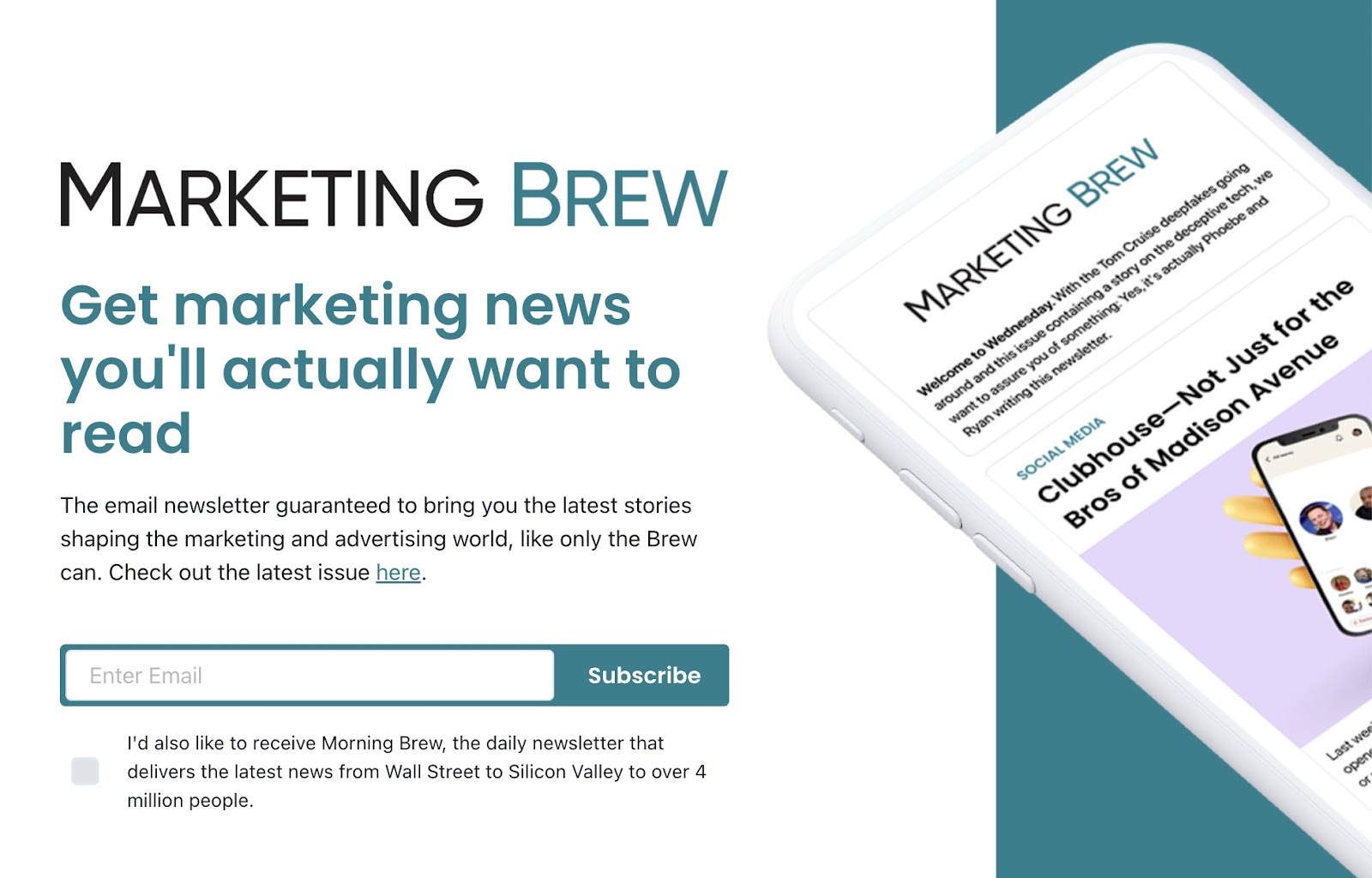
This information can spark content-generation ideas for timely articles and videos. Possibly even helping you to become a thought leader in your niche.
You can create content that not only addresses current trends but also offers analysis, predictions, or new perspectives. This helps establish your authority and expertise.
Over time, consistently producing well-informed, forward-thinking content can elevate your status to that of a thought leader, making you a go-to source for insights and commentary in your industry.
14. Use Content Curation Tools
Content curation tools, such as Feedly and Pocket, help you easily keep up with the latest trends and topics in your industry.
These tools work by letting you build a personalized feed.
You can add sources by searching for specific blogs and websites or by importing their RSS feeds.
Once you’ve added these sources, the tools automatically collect and show you the latest articles and posts from them.
This means you get a constantly updated stream of information tailored to your interests and industry.
For example, if you’re involved in the environmental sector, you might use Feedly to follow well-known blogs and news sites about green living.
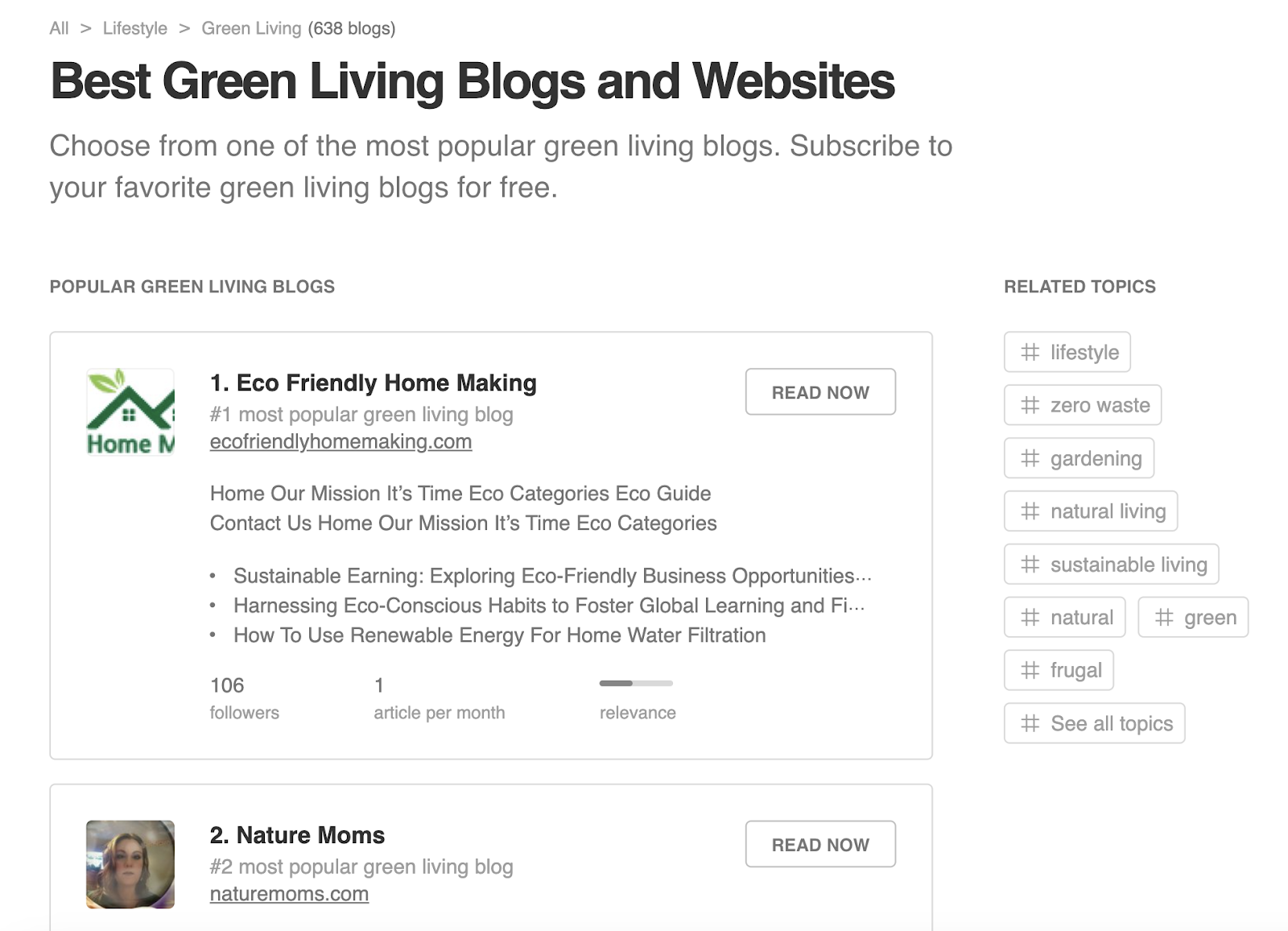
This allows you to quickly spot trending topics in your field.
For instance, you might come across articles on the latest sustainable living practices or innovations in eco-friendly products.
With this information, you can create relevant content such as “Top Sustainable Living Trends of the Year” or “Innovative Eco-Friendly Products Changing the Market,” ensuring your content is timely, informative, and aligned with what’s currently being talked about in the green living space.
15. Draw Inspiration from YouTube Channels
Follow YouTube channels related to your niche to see what topics are popular and how they are presented visually. This can be an excellent source for content ideas.
For instance, if you are in the fashion industry, watching popular fashion vloggers and content creators (like Justine Leconte, a popular fashion designer) can give you insights into current styles, consumer preferences, and industry trends.
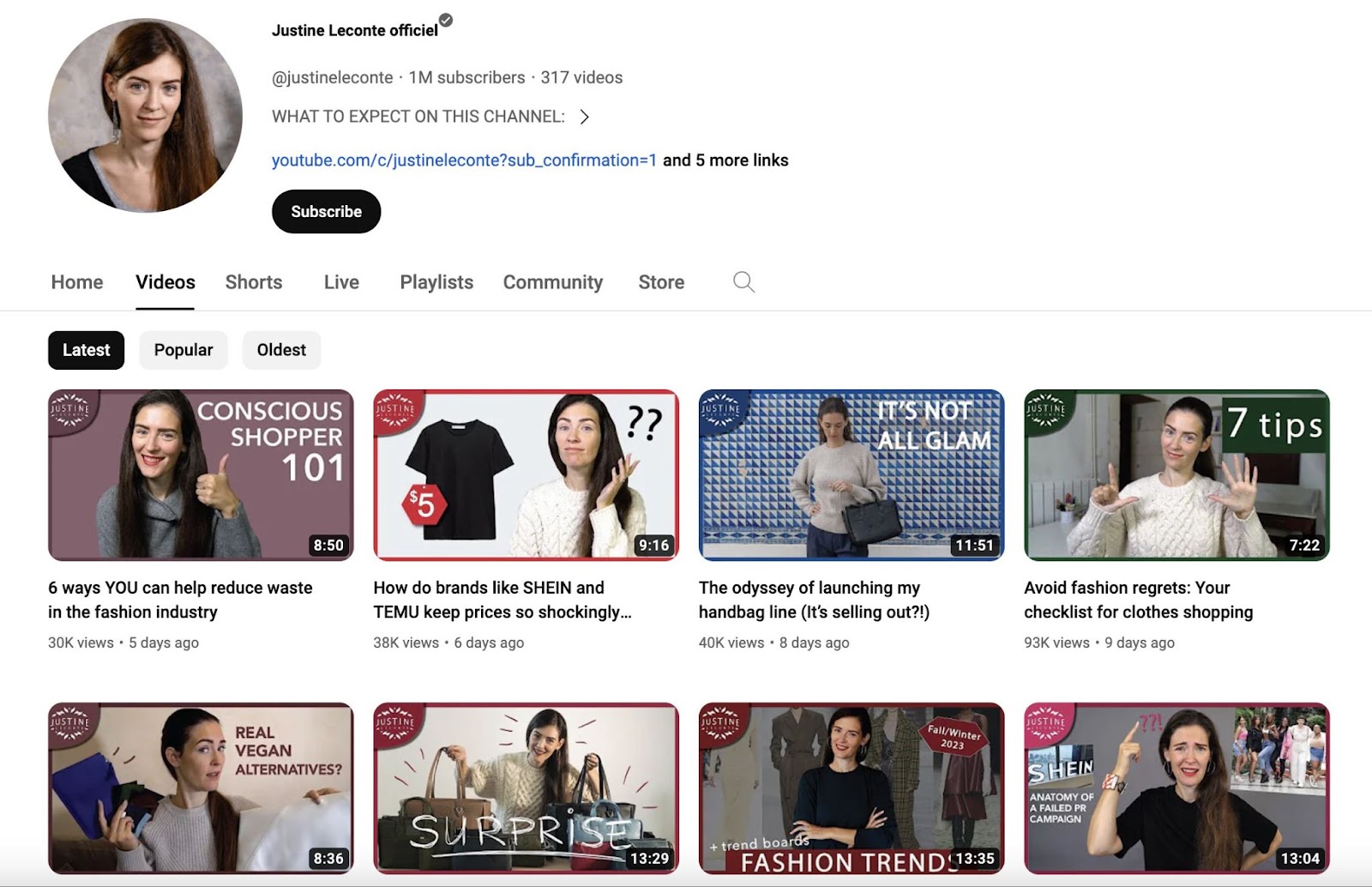
You can use these insights to create content that complements these trends, such as blog posts on “The Top Fashion Trends of the Season” or “How to Style Everyday Outfits.”
YouTube channels can also inspire ideas for format and presentation, helping you to diversify your content types, like incorporating video blogs or photo essays into your strategy.
16. Listen to Podcasts Related to Your Niche
Niche podcasts often feature in-depth discussions, interviews with experts, and analysis of current trends. They can be a rich source of content ideas.
Regularly listening to these podcasts can give you a deeper understanding of your industry and what interests your audience.
For example, if you’re in a business niche, listening to podcasts like “My First Million” or “The GaryVee Audio Experience” can inspire content ideas related to marketing, startups, funding, and more.
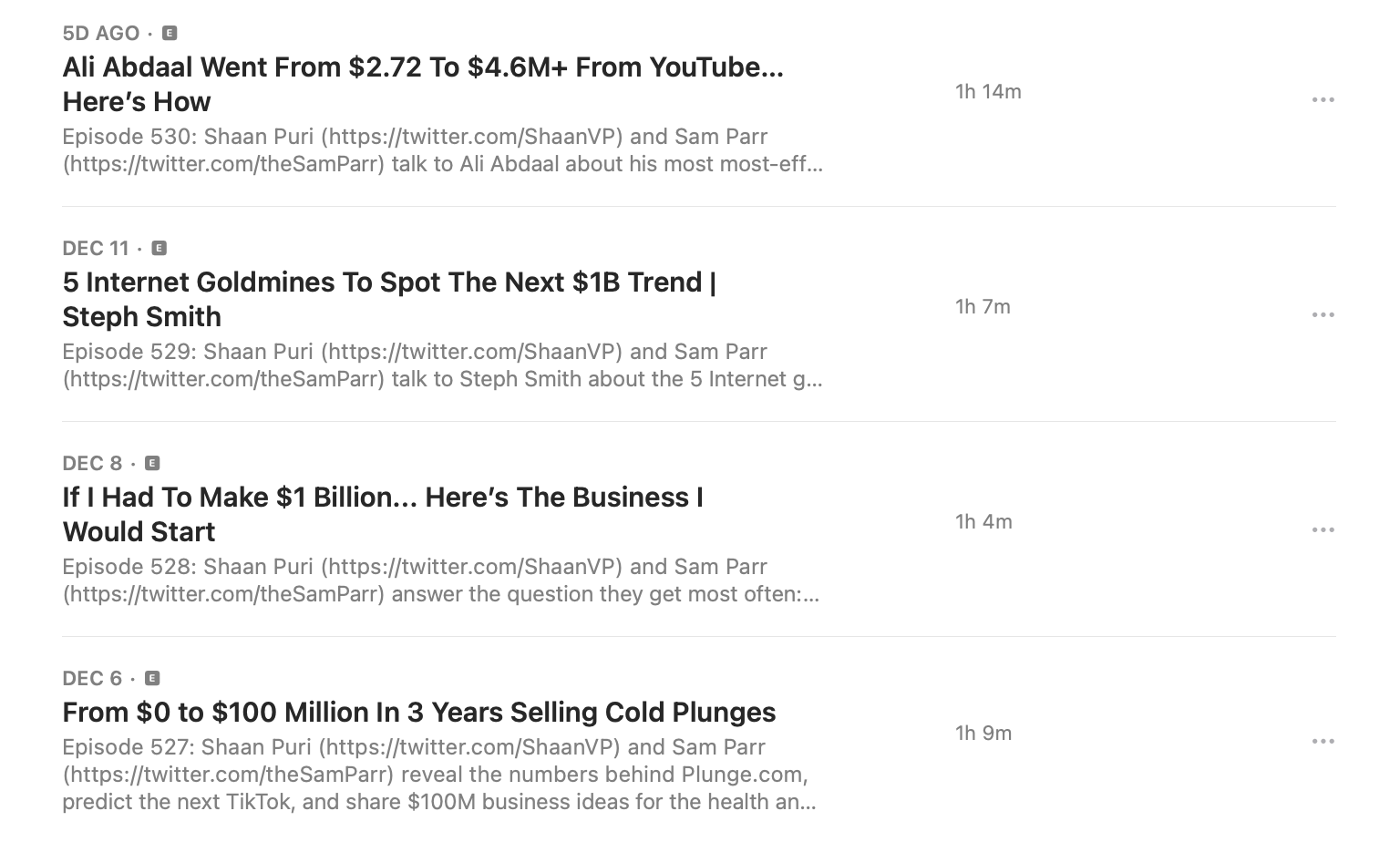
The topics discussed in these podcasts can be turned into blog posts, social media posts, infographics, or even guidebooks, providing your audience valuable information in the preferred format.
17. Stay Updated on the Latest Product Launches
Staying current with your industry’s latest technology and product releases can provide many ideas for website content.
Websites like TechCrunch, CNET, and Product Hunt can be excellent resources for staying informed about the latest gadgets, software, or services related to your industry.
For example, a TechCrunch article like the one shown below can be a source of new content ideas.

You can create articles focused on emerging tools that aid in travel planning.
You can write a detailed review of Pilot, exploring its features and benefits. Or produce a how-to guide on making the most of AI-based travel tools.
Also, comparison articles evaluating different AI travel planning solutions can be insightful for your audience.
This strategy of creating content around new product launches ensures your articles are both informative and relevant to current industry trends.
18. Leverage Insights from Recent Studies
Incorporating insights from recent studies can add credibility and depth to your content.
Look for recent research or surveys in your field—in academic journals, industry reports, or news articles.
For instance, if you cover health and wellness, a new study on meditation could be the basis for an informative article, video, and social media posts.

For the study above, you could create an article like “New Study Shows Daily Meditation Doesn’t Change Brain Structure.”
Using data from studies helps back your content with authoritative sources, making it more trustworthy and informative for your audience.
19. Engage with Your Existing Customers
Understanding existing customers’ experiences, needs, and pain points gives you a direct insight into what content will most benefit them.
So, direct interaction with them is an effective way to find content creating ideas. You can do this through surveys, feedback forms, or Zoom conversations.
For a fitness equipment business, direct feedback might highlight a need for more information on effective home workout routines.
In response, you could create a series of instructional posts or videos like “Maximizing Your Home Gym: Effective Routines with [Your Product].”
This approach ensures your content is relevant and strengthens customer relationships by showing that you value their feedback.
20. Discover New Content Ideas on Reddit
Reddit is a vibrant platform for uncovering diverse social and website content ideas. With its myriad of communities (called subreddits), you can find discussions on almost any topic imaginable.
Join subreddits that align with your niche to see what topics are trending and what questions are being asked.
For example, if you’re into gardening, you can go to the r/gardening subreddit and filter the results to see the top discussions in the past week, month, and year.
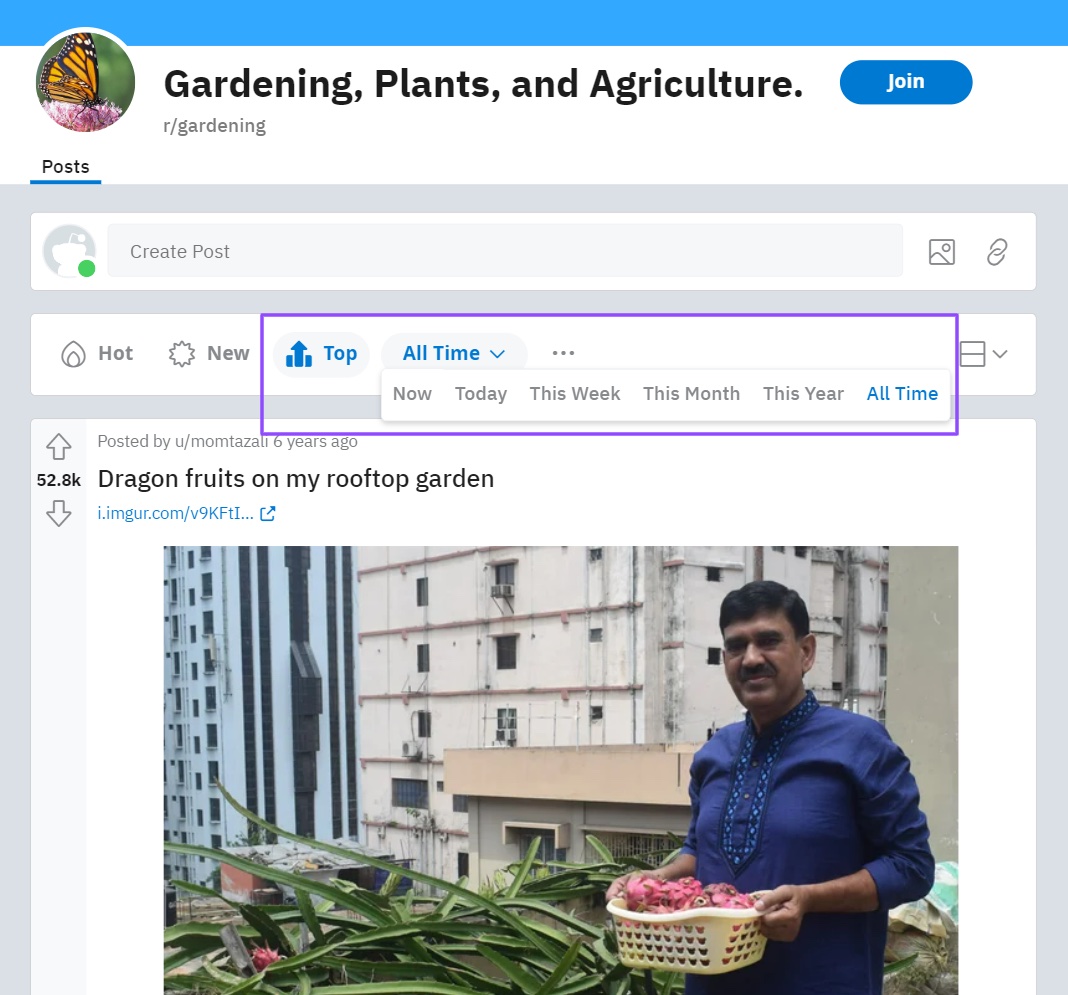
In the screenshot above, you can see a post on dragon fruits has received over 52,000 upvotes, which shows interest in the topic.
You can use that topic to create a range of guides and articles, like:
- How to Grow Dragon Fruit on Your Rooftop Garden
- Grow Dragon Fruit Plant in Your Backyard Garden in 5 Steps
- 10 Plants You Can Grow on Your Back Patio
The advantage of Reddit is its real-time, community-driven content, offering you a pulse on what’s currently engaging and thought-provoking in your industry. You can sort the results to see top posts “This Week” and you’ll find new content ideas every week.
21. Participate in Online Forum Discussions
Diving into online forums like Quora is another effective way to curate ideas for content creation. Unlike Reddit (a broader community platform), Quora is specifically designed for asking and answering questions.
This makes it an excellent place to understand what people are curious about in your niche.
For instance, if you specialize in personal finance, you can search “Personal Finance” on Quora to see a list of questions people have asked on the subject.
For example, in the screenshot below, you can see “What are the ten most important things about personal finance that someone without a finance background must know?” is a very popular question that has over 2,600 people following it.
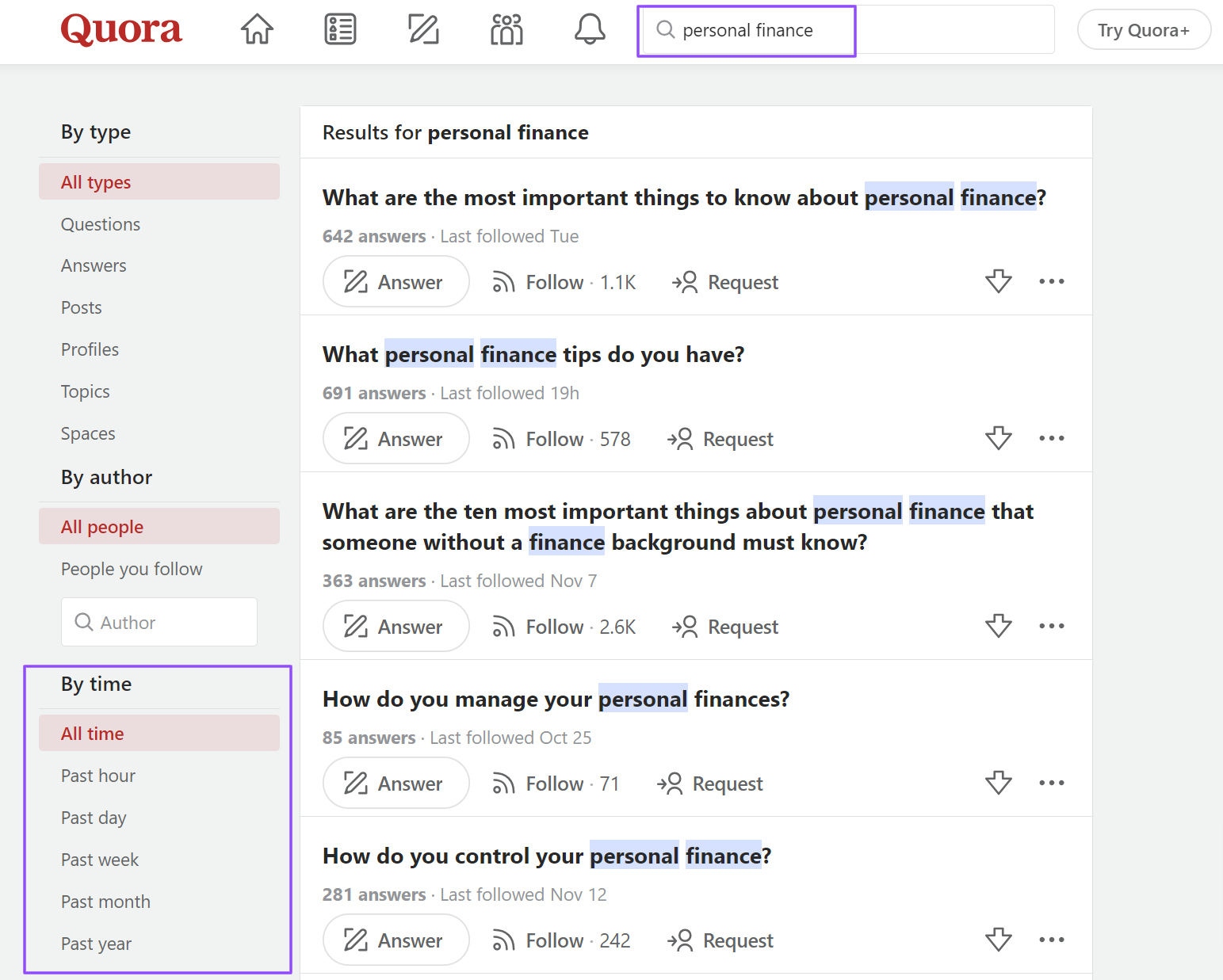
You can use this question as a topic for an article: 10 Personal Finance Tips People with Non-Finance Background Must Know
You can further skim through the answers the question has received to identify the most common tips. Especially the most upvoted answers. It’ll help you curate ideas for the content of your article.
Engaging with these questions reveals the interests and challenges of your audience, as well as specific in-demand topics. The insight allows you to tailor your content to answer these questions directly.
22. Review Blog Comments
Blog comments are a direct source of feedback and ideas from your audience.
Regularly review the comments on your blog posts. But also check out what people are saying on your competitors’ blogs.
This can reveal what readers enjoyed, what they want to know more about, and what they felt was missing.
For instance, if you’re in a culinary niche, you can look at websites like Minimalist Baker and go through the comment section of their blog posts. Here’s an example of their post and a comment it received:
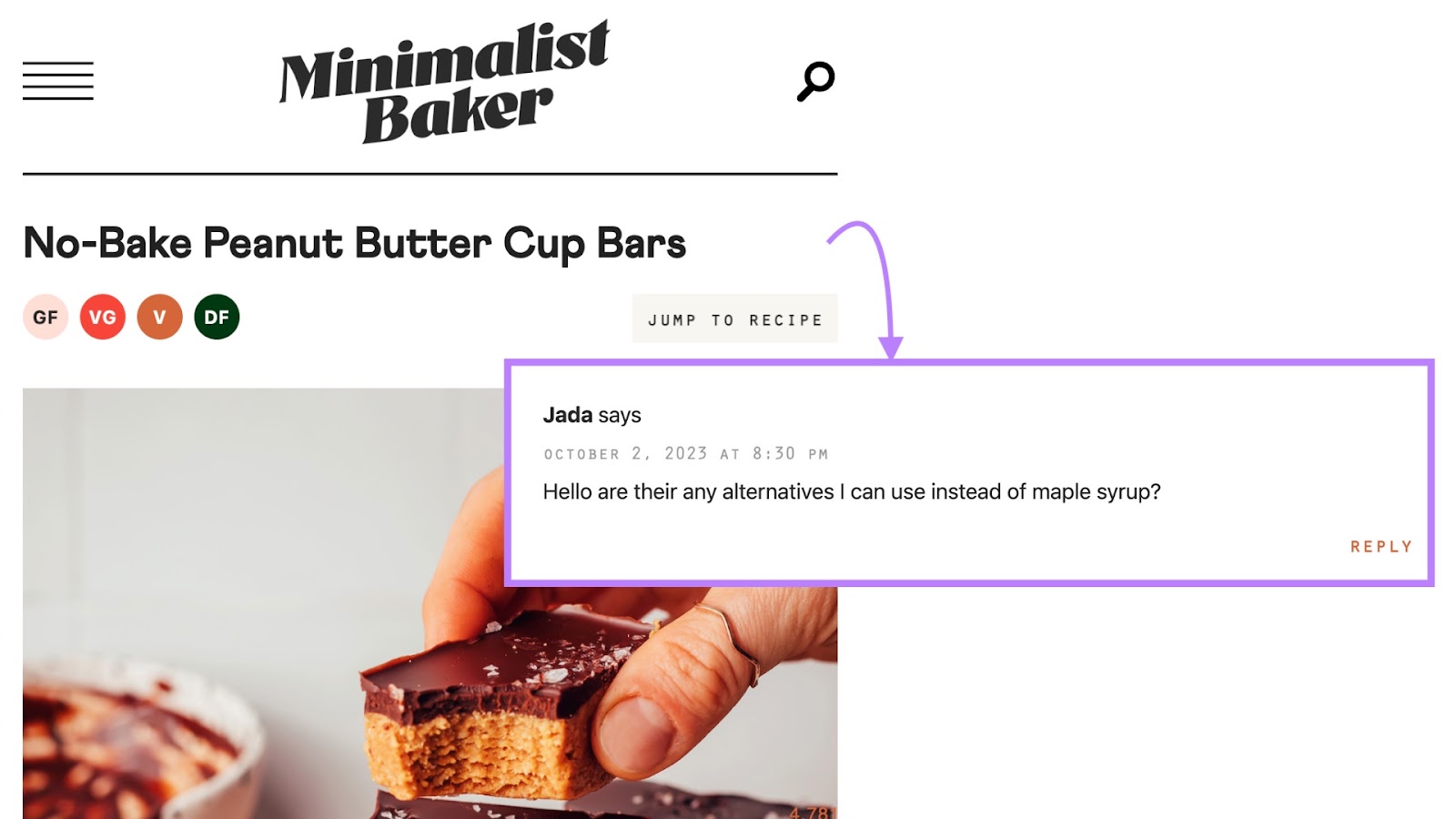
Based on this comment, you can create articles and social media posts on “maple syrup baking alternatives.”
You can use these comments as direct inspiration for your content. This approach provides you with targeted content ideas.
And if you’re addressing your own audience’s comments, it also demonstrates to your readers that their questions are considered and input is valued. Such responsiveness can build stronger connections with your audience and make your content more relatable.
23. Extract Insights from Conference Discussions and Q&As
Attending industry conferences, whether physically or online, is a fantastic way to gather fresh content ideas. These events include panel discussions, keynote addresses, fireside chats, and interactive Q&A sessions.
They offer a window into your field’s latest trends, concerns, and innovations.
Pay attention not just to the presentations but also to the questions raised by participants.
For instance, AFROTECH Conference 2023 featured several leaders and business owners discussing a range of tech-related topics, including the more inclusive future of AI.

These exchanges often highlight what professionals in the field are currently focusing on and what your audience might find intriguing. You could use this input to create content for your website and social media.
24. Turn Customer Reviews into Topics
Positive and negative customer reviews are an excellent source for content ideas, reflecting the direct voice of your audience. They highlight what customers appreciate and what they feel could be improved.
Here’s an example of a customer review a cloud phone system has on G2:

Based on this review, the brand can create content around its customer service and contract renewal. The content can reinforce that they have excellent customer support and transparent contract renewal.
The goal would be to address the concerns potential customers may have if they come across this negative review.
Even positive reviews can help you come up with content creation ideas. Like this one for the same cloud phone system:

The brand can create content around ease of use and user-friendliness—how important it is to choose a phone system that’s easy to use, how to evaluate a system for its user-friendliness, and more.
You can take cues from customer reviews to create highly relevant content on topics people prioritize in decision-making and usage.
25. Challenge Industry Myths and Misconceptions
Debunking myths and misconceptions in your industry can make for compelling content. This involves identifying common misunderstandings or outdated beliefs in your field and clarifying them through well-researched content.
If you’re in the field of nutrition, for example, you might tackle myths like “Carbs are always bad for you” with articles backed by scientific evidence and expert opinions.

Creating content that dispels these myths educates your audience and positions you as a knowledgeable and trustworthy source in your niche.
26. Brainstorm Ideas with Your Marketing Team
Brainstorming with your marketing team can generate various creative content ideas. Each member brings unique background, experiences, and insights, resulting in a diverse range of ideas.
In these sessions, encourage openness and value every suggestion, no matter how unconventional.
For instance, a team member with a background in graphic design might suggest visually driven content, while someone with experience in social media marketing could propose topics that address frequent customer inquiries.
This variety leads to diverse content themes, from in-depth “how-to” guides to visually engaging infographics.
The beauty of team brainstorming is its ability to blend different viewpoints and areas of expertise, culminating in content that is not only varied and interesting but also deeply reflective of your team’s collective knowledge and creativity.
27. Consult Customer-Facing Employees
Sales teams and customer support staff directly interact with your customers and understand their questions and concerns. They are a valuable resource for content ideas.
Regularly checking in with customer-facing employees can provide you with practical content ideas that address real customer issues.
For instance, if your sales team frequently gets questions about product compatibility, you could create a detailed guide or FAQ section on your website addressing these queries.
This strategy ensures your content enhances customer experience by preemptively answering common questions.
28. Ask Your Audience What They Want to Hear
Directly asking your target audience about their content preferences can lead to highly tailored and engaging material.
Use your social media channels, email newsletters, or even a simple survey on your website to gather their opinions.
For example, here’s Ali Abdaal, one of the world’s leading productivity experts, asking his community on YouTube what they would like to hear:
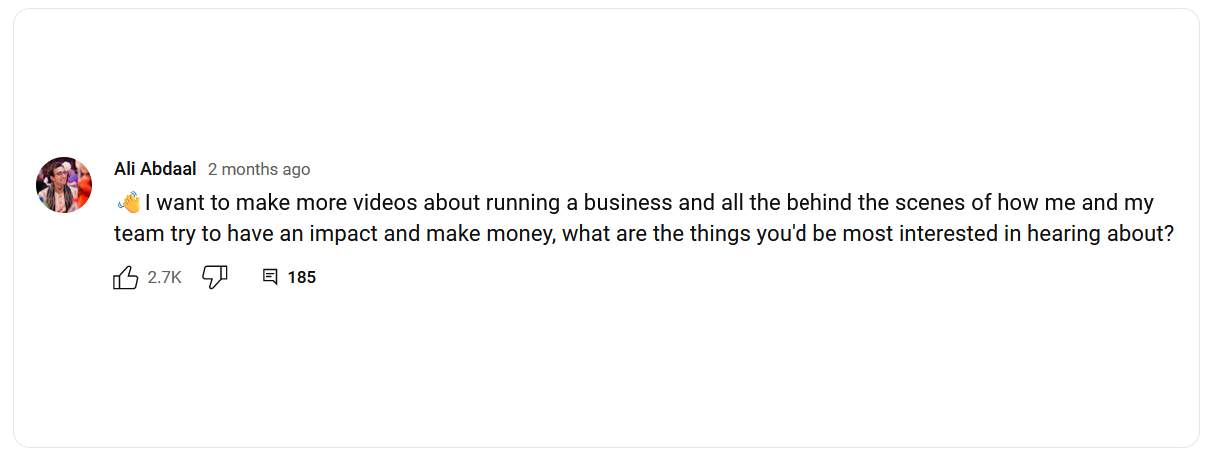
Engaging your audience this way provides you with targeted content ideas. It also makes your audience feel valued and like they’re part of your content creation process.
Turn Content Ideas Into Valuable Assets
There are hundreds of ways to come up with new content ideas. But not all of them will be meaningful to your audience.
So, while brainstorming topics and building your content calendar, focus on delivering value to your audience.
Semrush’s Topic Research offers highly relevant topics and sub-topics that align with your niche. Try it for free and find valuable content-creation ideas in seconds.
